Quick filters:
Gaodi Stock Photos and Images
 GUANGZHOU, CHINA - OCTOBER 24: This is an old residential alley with traditional houses near Gaodi Old Street on October 24, 2018 in Guangzhou Stock Photohttps://www.alamy.com/image-license-details/?v=1https://www.alamy.com/guangzhou-china-october-24-this-is-an-old-residential-alley-with-traditional-houses-near-gaodi-old-street-on-october-24-2018-in-guangzhou-image240803544.html
GUANGZHOU, CHINA - OCTOBER 24: This is an old residential alley with traditional houses near Gaodi Old Street on October 24, 2018 in Guangzhou Stock Photohttps://www.alamy.com/image-license-details/?v=1https://www.alamy.com/guangzhou-china-october-24-this-is-an-old-residential-alley-with-traditional-houses-near-gaodi-old-street-on-october-24-2018-in-guangzhou-image240803544.htmlRFRYNFAG–GUANGZHOU, CHINA - OCTOBER 24: This is an old residential alley with traditional houses near Gaodi Old Street on October 24, 2018 in Guangzhou
 Emperor Hongwu, 1st ruler of the Ming Dynasty (r. 1368-1398). Personal Name: Zhu Yuanzhang, Zhū Yuánzhāng Posthumous Name: Gaodi, Gāodì Temple Name: Taizu, Tàizǔ Reign Name: Ming Hongwu, Ming Hóngwǔ The Hongwu Emperor was the founder and first emperor (1368–98) of the Ming Dynasty of China. His era name, Hongwu, means 'vastly martial'. In the middle of the 14th century, with famine, plagues and peasant revolts sweeping across China, Zhu became a leader of an army that conquered China, ending the Yuan Dynasty and forcing the Mongols to retreat to the Mongolian steppes. With his seizure of the Stock Photohttps://www.alamy.com/image-license-details/?v=1https://www.alamy.com/emperor-hongwu-1st-ruler-of-the-ming-dynasty-r-1368-1398-personal-name-zhu-yuanzhang-zh-yunzhng-posthumous-name-gaodi-god-temple-name-taizu-tiz-reign-name-ming-hongwu-ming-hngw-the-hongwu-emperor-was-the-founder-and-first-emperor-136898-of-the-ming-dynasty-of-china-his-era-name-hongwu-means-vastly-martial-in-the-middle-of-the-14th-century-with-famine-plagues-and-peasant-revolts-sweeping-across-china-zhu-became-a-leader-of-an-army-that-conquered-china-ending-the-yuan-dynasty-and-forcing-the-mongols-to-retreat-to-the-mongolian-steppes-with-his-seizure-of-the-image344257692.html
Emperor Hongwu, 1st ruler of the Ming Dynasty (r. 1368-1398). Personal Name: Zhu Yuanzhang, Zhū Yuánzhāng Posthumous Name: Gaodi, Gāodì Temple Name: Taizu, Tàizǔ Reign Name: Ming Hongwu, Ming Hóngwǔ The Hongwu Emperor was the founder and first emperor (1368–98) of the Ming Dynasty of China. His era name, Hongwu, means 'vastly martial'. In the middle of the 14th century, with famine, plagues and peasant revolts sweeping across China, Zhu became a leader of an army that conquered China, ending the Yuan Dynasty and forcing the Mongols to retreat to the Mongolian steppes. With his seizure of the Stock Photohttps://www.alamy.com/image-license-details/?v=1https://www.alamy.com/emperor-hongwu-1st-ruler-of-the-ming-dynasty-r-1368-1398-personal-name-zhu-yuanzhang-zh-yunzhng-posthumous-name-gaodi-god-temple-name-taizu-tiz-reign-name-ming-hongwu-ming-hngw-the-hongwu-emperor-was-the-founder-and-first-emperor-136898-of-the-ming-dynasty-of-china-his-era-name-hongwu-means-vastly-martial-in-the-middle-of-the-14th-century-with-famine-plagues-and-peasant-revolts-sweeping-across-china-zhu-became-a-leader-of-an-army-that-conquered-china-ending-the-yuan-dynasty-and-forcing-the-mongols-to-retreat-to-the-mongolian-steppes-with-his-seizure-of-the-image344257692.htmlRM2B0285G–Emperor Hongwu, 1st ruler of the Ming Dynasty (r. 1368-1398). Personal Name: Zhu Yuanzhang, Zhū Yuánzhāng Posthumous Name: Gaodi, Gāodì Temple Name: Taizu, Tàizǔ Reign Name: Ming Hongwu, Ming Hóngwǔ The Hongwu Emperor was the founder and first emperor (1368–98) of the Ming Dynasty of China. His era name, Hongwu, means 'vastly martial'. In the middle of the 14th century, with famine, plagues and peasant revolts sweeping across China, Zhu became a leader of an army that conquered China, ending the Yuan Dynasty and forcing the Mongols to retreat to the Mongolian steppes. With his seizure of the
 shaded stone pillars in Barcelona Stock Photohttps://www.alamy.com/image-license-details/?v=1https://www.alamy.com/stock-photo-shaded-stone-pillars-in-barcelona-176059658.html
shaded stone pillars in Barcelona Stock Photohttps://www.alamy.com/image-license-details/?v=1https://www.alamy.com/stock-photo-shaded-stone-pillars-in-barcelona-176059658.htmlRFM6C5TX–shaded stone pillars in Barcelona
 Highland Gallery, 798 Art District, Beijing, China Stock Photohttps://www.alamy.com/image-license-details/?v=1https://www.alamy.com/stock-photo-highland-gallery-798-art-district-beijing-china-25064006.html
Highland Gallery, 798 Art District, Beijing, China Stock Photohttps://www.alamy.com/image-license-details/?v=1https://www.alamy.com/stock-photo-highland-gallery-798-art-district-beijing-china-25064006.htmlRMBCNNB2–Highland Gallery, 798 Art District, Beijing, China
 GUANGZHOU, CHINA - OCTOBER 24: This is an old residential alley with traditional houses near Gaodi Old Street on October 24, 2018 in Guangzhou Stock Photohttps://www.alamy.com/image-license-details/?v=1https://www.alamy.com/guangzhou-china-october-24-this-is-an-old-residential-alley-with-traditional-houses-near-gaodi-old-street-on-october-24-2018-in-guangzhou-image240803541.html
GUANGZHOU, CHINA - OCTOBER 24: This is an old residential alley with traditional houses near Gaodi Old Street on October 24, 2018 in Guangzhou Stock Photohttps://www.alamy.com/image-license-details/?v=1https://www.alamy.com/guangzhou-china-october-24-this-is-an-old-residential-alley-with-traditional-houses-near-gaodi-old-street-on-october-24-2018-in-guangzhou-image240803541.htmlRFRYNFAD–GUANGZHOU, CHINA - OCTOBER 24: This is an old residential alley with traditional houses near Gaodi Old Street on October 24, 2018 in Guangzhou
 Emperor Hongwu, 1st ruler of the Ming Dynasty (r. 1368-1398). Personal Name: Zhu Yuanzhang, Zhū Yuánzhāng Posthumous Name: Gaodi, Gāodì Temple Name: Taizu, Tàizǔ Reign Name: Ming Hongwu, Ming Hóngwǔ The Hongwu Emperor was the founder and first emperor (1368–98) of the Ming Dynasty of China. His era name, Hongwu, means 'vastly martial'. In the middle of the 14th century, with famine, plagues and peasant revolts sweeping across China, Zhu became a leader of an army that conquered China, ending the Yuan Dynasty and forcing the Mongols to retreat to the Mongolian steppes. With his seizure of the Stock Photohttps://www.alamy.com/image-license-details/?v=1https://www.alamy.com/emperor-hongwu-1st-ruler-of-the-ming-dynasty-r-1368-1398-personal-name-zhu-yuanzhang-zh-yunzhng-posthumous-name-gaodi-god-temple-name-taizu-tiz-reign-name-ming-hongwu-ming-hngw-the-hongwu-emperor-was-the-founder-and-first-emperor-136898-of-the-ming-dynasty-of-china-his-era-name-hongwu-means-vastly-martial-in-the-middle-of-the-14th-century-with-famine-plagues-and-peasant-revolts-sweeping-across-china-zhu-became-a-leader-of-an-army-that-conquered-china-ending-the-yuan-dynasty-and-forcing-the-mongols-to-retreat-to-the-mongolian-steppes-with-his-seizure-of-the-image344257693.html
Emperor Hongwu, 1st ruler of the Ming Dynasty (r. 1368-1398). Personal Name: Zhu Yuanzhang, Zhū Yuánzhāng Posthumous Name: Gaodi, Gāodì Temple Name: Taizu, Tàizǔ Reign Name: Ming Hongwu, Ming Hóngwǔ The Hongwu Emperor was the founder and first emperor (1368–98) of the Ming Dynasty of China. His era name, Hongwu, means 'vastly martial'. In the middle of the 14th century, with famine, plagues and peasant revolts sweeping across China, Zhu became a leader of an army that conquered China, ending the Yuan Dynasty and forcing the Mongols to retreat to the Mongolian steppes. With his seizure of the Stock Photohttps://www.alamy.com/image-license-details/?v=1https://www.alamy.com/emperor-hongwu-1st-ruler-of-the-ming-dynasty-r-1368-1398-personal-name-zhu-yuanzhang-zh-yunzhng-posthumous-name-gaodi-god-temple-name-taizu-tiz-reign-name-ming-hongwu-ming-hngw-the-hongwu-emperor-was-the-founder-and-first-emperor-136898-of-the-ming-dynasty-of-china-his-era-name-hongwu-means-vastly-martial-in-the-middle-of-the-14th-century-with-famine-plagues-and-peasant-revolts-sweeping-across-china-zhu-became-a-leader-of-an-army-that-conquered-china-ending-the-yuan-dynasty-and-forcing-the-mongols-to-retreat-to-the-mongolian-steppes-with-his-seizure-of-the-image344257693.htmlRM2B0285H–Emperor Hongwu, 1st ruler of the Ming Dynasty (r. 1368-1398). Personal Name: Zhu Yuanzhang, Zhū Yuánzhāng Posthumous Name: Gaodi, Gāodì Temple Name: Taizu, Tàizǔ Reign Name: Ming Hongwu, Ming Hóngwǔ The Hongwu Emperor was the founder and first emperor (1368–98) of the Ming Dynasty of China. His era name, Hongwu, means 'vastly martial'. In the middle of the 14th century, with famine, plagues and peasant revolts sweeping across China, Zhu became a leader of an army that conquered China, ending the Yuan Dynasty and forcing the Mongols to retreat to the Mongolian steppes. With his seizure of the
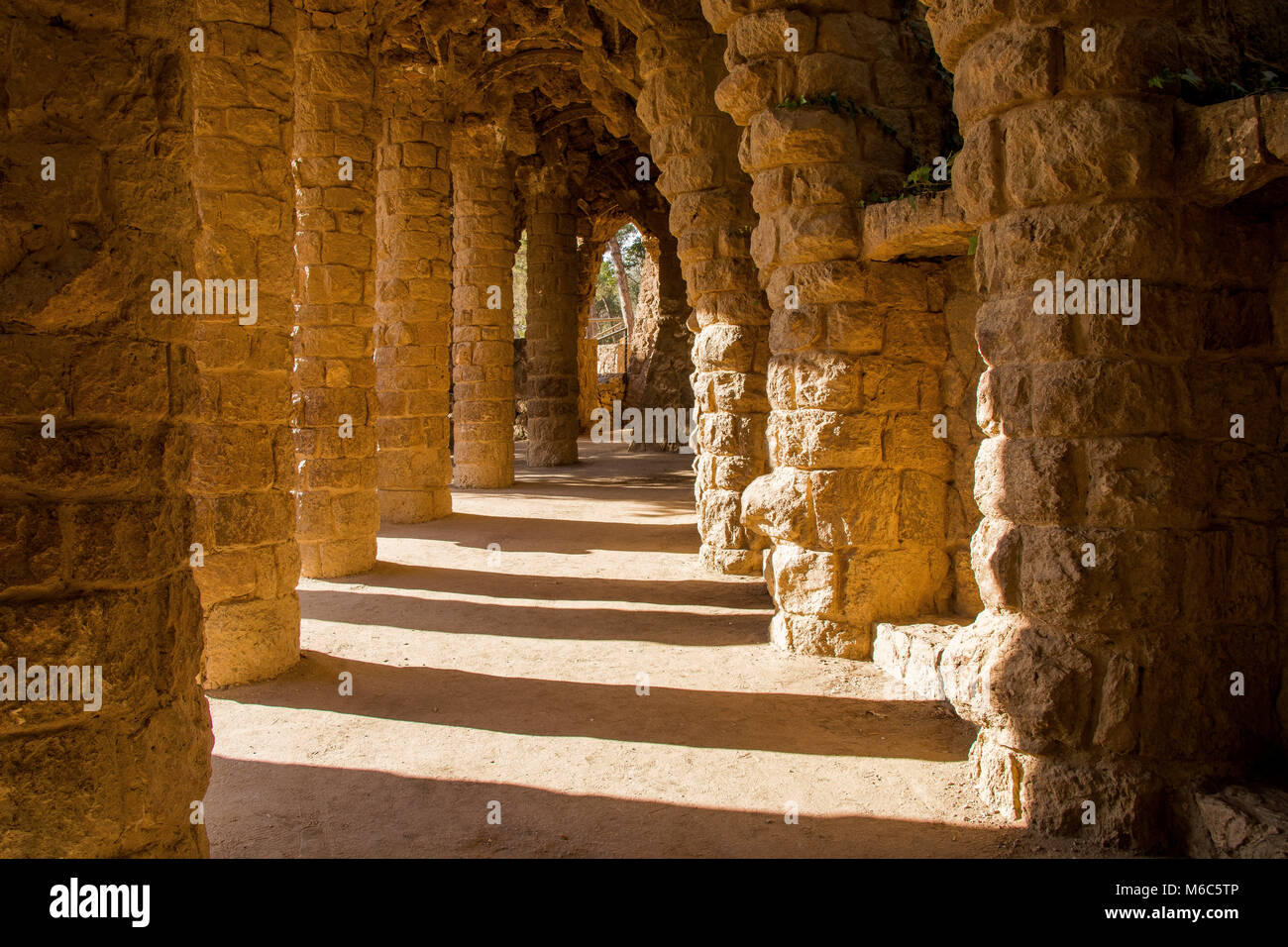 shaded stone pillars in Barcelona Stock Photohttps://www.alamy.com/image-license-details/?v=1https://www.alamy.com/stock-photo-shaded-stone-pillars-in-barcelona-176059654.html
shaded stone pillars in Barcelona Stock Photohttps://www.alamy.com/image-license-details/?v=1https://www.alamy.com/stock-photo-shaded-stone-pillars-in-barcelona-176059654.htmlRFM6C5TP–shaded stone pillars in Barcelona
 GUANGZHOU, CHINA - OCTOBER 24: This is Gaodi Old Street, a famous old street with traditional shops and historic buildings on October 24, 2018 in Guan Stock Photohttps://www.alamy.com/image-license-details/?v=1https://www.alamy.com/guangzhou-china-october-24-this-is-gaodi-old-street-a-famous-old-street-with-traditional-shops-and-historic-buildings-on-october-24-2018-in-guan-image240803556.html
GUANGZHOU, CHINA - OCTOBER 24: This is Gaodi Old Street, a famous old street with traditional shops and historic buildings on October 24, 2018 in Guan Stock Photohttps://www.alamy.com/image-license-details/?v=1https://www.alamy.com/guangzhou-china-october-24-this-is-gaodi-old-street-a-famous-old-street-with-traditional-shops-and-historic-buildings-on-october-24-2018-in-guan-image240803556.htmlRFRYNFB0–GUANGZHOU, CHINA - OCTOBER 24: This is Gaodi Old Street, a famous old street with traditional shops and historic buildings on October 24, 2018 in Guan
 Emperor Hongwu, 1st ruler of the Ming Dynasty (r. 1368-1398). Personal Name: Zhu Yuanzhang, Zhū Yuánzhāng Posthumous Name: Gaodi, Gāodì Temple Name: Taizu, Tàizǔ Reign Name: Ming Hongwu, Ming Hóngwǔ The Hongwu Emperor was the founder and first emperor (1368–98) of the Ming Dynasty of China. His era name, Hongwu, means 'vastly martial'. In the middle of the 14th century, with famine, plagues and peasant revolts sweeping across China, Zhu became a leader of an army that conquered China, ending the Yuan Dynasty and forcing the Mongols to retreat to the Mongolian steppes. With his seizure of the Stock Photohttps://www.alamy.com/image-license-details/?v=1https://www.alamy.com/emperor-hongwu-1st-ruler-of-the-ming-dynasty-r-1368-1398-personal-name-zhu-yuanzhang-zh-yunzhng-posthumous-name-gaodi-god-temple-name-taizu-tiz-reign-name-ming-hongwu-ming-hngw-the-hongwu-emperor-was-the-founder-and-first-emperor-136898-of-the-ming-dynasty-of-china-his-era-name-hongwu-means-vastly-martial-in-the-middle-of-the-14th-century-with-famine-plagues-and-peasant-revolts-sweeping-across-china-zhu-became-a-leader-of-an-army-that-conquered-china-ending-the-yuan-dynasty-and-forcing-the-mongols-to-retreat-to-the-mongolian-steppes-with-his-seizure-of-the-image344257694.html
Emperor Hongwu, 1st ruler of the Ming Dynasty (r. 1368-1398). Personal Name: Zhu Yuanzhang, Zhū Yuánzhāng Posthumous Name: Gaodi, Gāodì Temple Name: Taizu, Tàizǔ Reign Name: Ming Hongwu, Ming Hóngwǔ The Hongwu Emperor was the founder and first emperor (1368–98) of the Ming Dynasty of China. His era name, Hongwu, means 'vastly martial'. In the middle of the 14th century, with famine, plagues and peasant revolts sweeping across China, Zhu became a leader of an army that conquered China, ending the Yuan Dynasty and forcing the Mongols to retreat to the Mongolian steppes. With his seizure of the Stock Photohttps://www.alamy.com/image-license-details/?v=1https://www.alamy.com/emperor-hongwu-1st-ruler-of-the-ming-dynasty-r-1368-1398-personal-name-zhu-yuanzhang-zh-yunzhng-posthumous-name-gaodi-god-temple-name-taizu-tiz-reign-name-ming-hongwu-ming-hngw-the-hongwu-emperor-was-the-founder-and-first-emperor-136898-of-the-ming-dynasty-of-china-his-era-name-hongwu-means-vastly-martial-in-the-middle-of-the-14th-century-with-famine-plagues-and-peasant-revolts-sweeping-across-china-zhu-became-a-leader-of-an-army-that-conquered-china-ending-the-yuan-dynasty-and-forcing-the-mongols-to-retreat-to-the-mongolian-steppes-with-his-seizure-of-the-image344257694.htmlRM2B0285J–Emperor Hongwu, 1st ruler of the Ming Dynasty (r. 1368-1398). Personal Name: Zhu Yuanzhang, Zhū Yuánzhāng Posthumous Name: Gaodi, Gāodì Temple Name: Taizu, Tàizǔ Reign Name: Ming Hongwu, Ming Hóngwǔ The Hongwu Emperor was the founder and first emperor (1368–98) of the Ming Dynasty of China. His era name, Hongwu, means 'vastly martial'. In the middle of the 14th century, with famine, plagues and peasant revolts sweeping across China, Zhu became a leader of an army that conquered China, ending the Yuan Dynasty and forcing the Mongols to retreat to the Mongolian steppes. With his seizure of the
 Emperor Hongwu, 1st ruler of the Ming Dynasty (r. 1368-1398). Personal Name: Zhu Yuanzhang, Zhū Yuánzhāng Posthumous Name: Gaodi, Gāodì Temple Name: Taizu, Tàizǔ Reign Name: Ming Hongwu, Ming Hóngwǔ The Hongwu Emperor was the founder and first emperor (1368–98) of the Ming Dynasty of China. His era name, Hongwu, means 'vastly martial'. In the middle of the 14th century, with famine, plagues and peasant revolts sweeping across China, Zhu became a leader of an army that conquered China, ending the Yuan Dynasty and forcing the Mongols to retreat to the Mongolian steppes. With his seizure of the Stock Photohttps://www.alamy.com/image-license-details/?v=1https://www.alamy.com/emperor-hongwu-1st-ruler-of-the-ming-dynasty-r-1368-1398-personal-name-zhu-yuanzhang-zh-yunzhng-posthumous-name-gaodi-god-temple-name-taizu-tiz-reign-name-ming-hongwu-ming-hngw-the-hongwu-emperor-was-the-founder-and-first-emperor-136898-of-the-ming-dynasty-of-china-his-era-name-hongwu-means-vastly-martial-in-the-middle-of-the-14th-century-with-famine-plagues-and-peasant-revolts-sweeping-across-china-zhu-became-a-leader-of-an-army-that-conquered-china-ending-the-yuan-dynasty-and-forcing-the-mongols-to-retreat-to-the-mongolian-steppes-with-his-seizure-of-the-image344257793.html
Emperor Hongwu, 1st ruler of the Ming Dynasty (r. 1368-1398). Personal Name: Zhu Yuanzhang, Zhū Yuánzhāng Posthumous Name: Gaodi, Gāodì Temple Name: Taizu, Tàizǔ Reign Name: Ming Hongwu, Ming Hóngwǔ The Hongwu Emperor was the founder and first emperor (1368–98) of the Ming Dynasty of China. His era name, Hongwu, means 'vastly martial'. In the middle of the 14th century, with famine, plagues and peasant revolts sweeping across China, Zhu became a leader of an army that conquered China, ending the Yuan Dynasty and forcing the Mongols to retreat to the Mongolian steppes. With his seizure of the Stock Photohttps://www.alamy.com/image-license-details/?v=1https://www.alamy.com/emperor-hongwu-1st-ruler-of-the-ming-dynasty-r-1368-1398-personal-name-zhu-yuanzhang-zh-yunzhng-posthumous-name-gaodi-god-temple-name-taizu-tiz-reign-name-ming-hongwu-ming-hngw-the-hongwu-emperor-was-the-founder-and-first-emperor-136898-of-the-ming-dynasty-of-china-his-era-name-hongwu-means-vastly-martial-in-the-middle-of-the-14th-century-with-famine-plagues-and-peasant-revolts-sweeping-across-china-zhu-became-a-leader-of-an-army-that-conquered-china-ending-the-yuan-dynasty-and-forcing-the-mongols-to-retreat-to-the-mongolian-steppes-with-his-seizure-of-the-image344257793.htmlRM2B02895–Emperor Hongwu, 1st ruler of the Ming Dynasty (r. 1368-1398). Personal Name: Zhu Yuanzhang, Zhū Yuánzhāng Posthumous Name: Gaodi, Gāodì Temple Name: Taizu, Tàizǔ Reign Name: Ming Hongwu, Ming Hóngwǔ The Hongwu Emperor was the founder and first emperor (1368–98) of the Ming Dynasty of China. His era name, Hongwu, means 'vastly martial'. In the middle of the 14th century, with famine, plagues and peasant revolts sweeping across China, Zhu became a leader of an army that conquered China, ending the Yuan Dynasty and forcing the Mongols to retreat to the Mongolian steppes. With his seizure of the
 GUANGZHOU, CHINA - OCTOBER 24: This is Gaodi Old Street, a famous old street with traditional shops and historic buildings on October 24, 2018 in Guan Stock Photohttps://www.alamy.com/image-license-details/?v=1https://www.alamy.com/guangzhou-china-october-24-this-is-gaodi-old-street-a-famous-old-street-with-traditional-shops-and-historic-buildings-on-october-24-2018-in-guan-image240803574.html
GUANGZHOU, CHINA - OCTOBER 24: This is Gaodi Old Street, a famous old street with traditional shops and historic buildings on October 24, 2018 in Guan Stock Photohttps://www.alamy.com/image-license-details/?v=1https://www.alamy.com/guangzhou-china-october-24-this-is-gaodi-old-street-a-famous-old-street-with-traditional-shops-and-historic-buildings-on-october-24-2018-in-guan-image240803574.htmlRFRYNFBJ–GUANGZHOU, CHINA - OCTOBER 24: This is Gaodi Old Street, a famous old street with traditional shops and historic buildings on October 24, 2018 in Guan
 Emperor Hongwu, 1st ruler of the Ming Dynasty (r. 1368-1398). Personal Name: Zhu Yuanzhang, Zhū Yuánzhāng Posthumous Name: Gaodi, Gāodì Temple Name: Taizu, Tàizǔ Reign Name: Ming Hongwu, Ming Hóngwǔ The Hongwu Emperor was the founder and first emperor (1368–98) of the Ming Dynasty of China. His era name, Hongwu, means 'vastly martial'. In the middle of the 14th century, with famine, plagues and peasant revolts sweeping across China, Zhu became a leader of an army that conquered China, ending the Yuan Dynasty and forcing the Mongols to retreat to the Mongolian steppes. With his seizure of the Stock Photohttps://www.alamy.com/image-license-details/?v=1https://www.alamy.com/emperor-hongwu-1st-ruler-of-the-ming-dynasty-r-1368-1398-personal-name-zhu-yuanzhang-zh-yunzhng-posthumous-name-gaodi-god-temple-name-taizu-tiz-reign-name-ming-hongwu-ming-hngw-the-hongwu-emperor-was-the-founder-and-first-emperor-136898-of-the-ming-dynasty-of-china-his-era-name-hongwu-means-vastly-martial-in-the-middle-of-the-14th-century-with-famine-plagues-and-peasant-revolts-sweeping-across-china-zhu-became-a-leader-of-an-army-that-conquered-china-ending-the-yuan-dynasty-and-forcing-the-mongols-to-retreat-to-the-mongolian-steppes-with-his-seizure-of-the-image344257795.html
Emperor Hongwu, 1st ruler of the Ming Dynasty (r. 1368-1398). Personal Name: Zhu Yuanzhang, Zhū Yuánzhāng Posthumous Name: Gaodi, Gāodì Temple Name: Taizu, Tàizǔ Reign Name: Ming Hongwu, Ming Hóngwǔ The Hongwu Emperor was the founder and first emperor (1368–98) of the Ming Dynasty of China. His era name, Hongwu, means 'vastly martial'. In the middle of the 14th century, with famine, plagues and peasant revolts sweeping across China, Zhu became a leader of an army that conquered China, ending the Yuan Dynasty and forcing the Mongols to retreat to the Mongolian steppes. With his seizure of the Stock Photohttps://www.alamy.com/image-license-details/?v=1https://www.alamy.com/emperor-hongwu-1st-ruler-of-the-ming-dynasty-r-1368-1398-personal-name-zhu-yuanzhang-zh-yunzhng-posthumous-name-gaodi-god-temple-name-taizu-tiz-reign-name-ming-hongwu-ming-hngw-the-hongwu-emperor-was-the-founder-and-first-emperor-136898-of-the-ming-dynasty-of-china-his-era-name-hongwu-means-vastly-martial-in-the-middle-of-the-14th-century-with-famine-plagues-and-peasant-revolts-sweeping-across-china-zhu-became-a-leader-of-an-army-that-conquered-china-ending-the-yuan-dynasty-and-forcing-the-mongols-to-retreat-to-the-mongolian-steppes-with-his-seizure-of-the-image344257795.htmlRM2B02897–Emperor Hongwu, 1st ruler of the Ming Dynasty (r. 1368-1398). Personal Name: Zhu Yuanzhang, Zhū Yuánzhāng Posthumous Name: Gaodi, Gāodì Temple Name: Taizu, Tàizǔ Reign Name: Ming Hongwu, Ming Hóngwǔ The Hongwu Emperor was the founder and first emperor (1368–98) of the Ming Dynasty of China. His era name, Hongwu, means 'vastly martial'. In the middle of the 14th century, with famine, plagues and peasant revolts sweeping across China, Zhu became a leader of an army that conquered China, ending the Yuan Dynasty and forcing the Mongols to retreat to the Mongolian steppes. With his seizure of the
 GUANGZHOU, CHINA - OCTOBER 24: This is Gaodi Old Street, a famous old street with traditional shops and historic buildings on October 24, 2018 in Guan Stock Photohttps://www.alamy.com/image-license-details/?v=1https://www.alamy.com/guangzhou-china-october-24-this-is-gaodi-old-street-a-famous-old-street-with-traditional-shops-and-historic-buildings-on-october-24-2018-in-guan-image240803565.html
GUANGZHOU, CHINA - OCTOBER 24: This is Gaodi Old Street, a famous old street with traditional shops and historic buildings on October 24, 2018 in Guan Stock Photohttps://www.alamy.com/image-license-details/?v=1https://www.alamy.com/guangzhou-china-october-24-this-is-gaodi-old-street-a-famous-old-street-with-traditional-shops-and-historic-buildings-on-october-24-2018-in-guan-image240803565.htmlRFRYNFB9–GUANGZHOU, CHINA - OCTOBER 24: This is Gaodi Old Street, a famous old street with traditional shops and historic buildings on October 24, 2018 in Guan
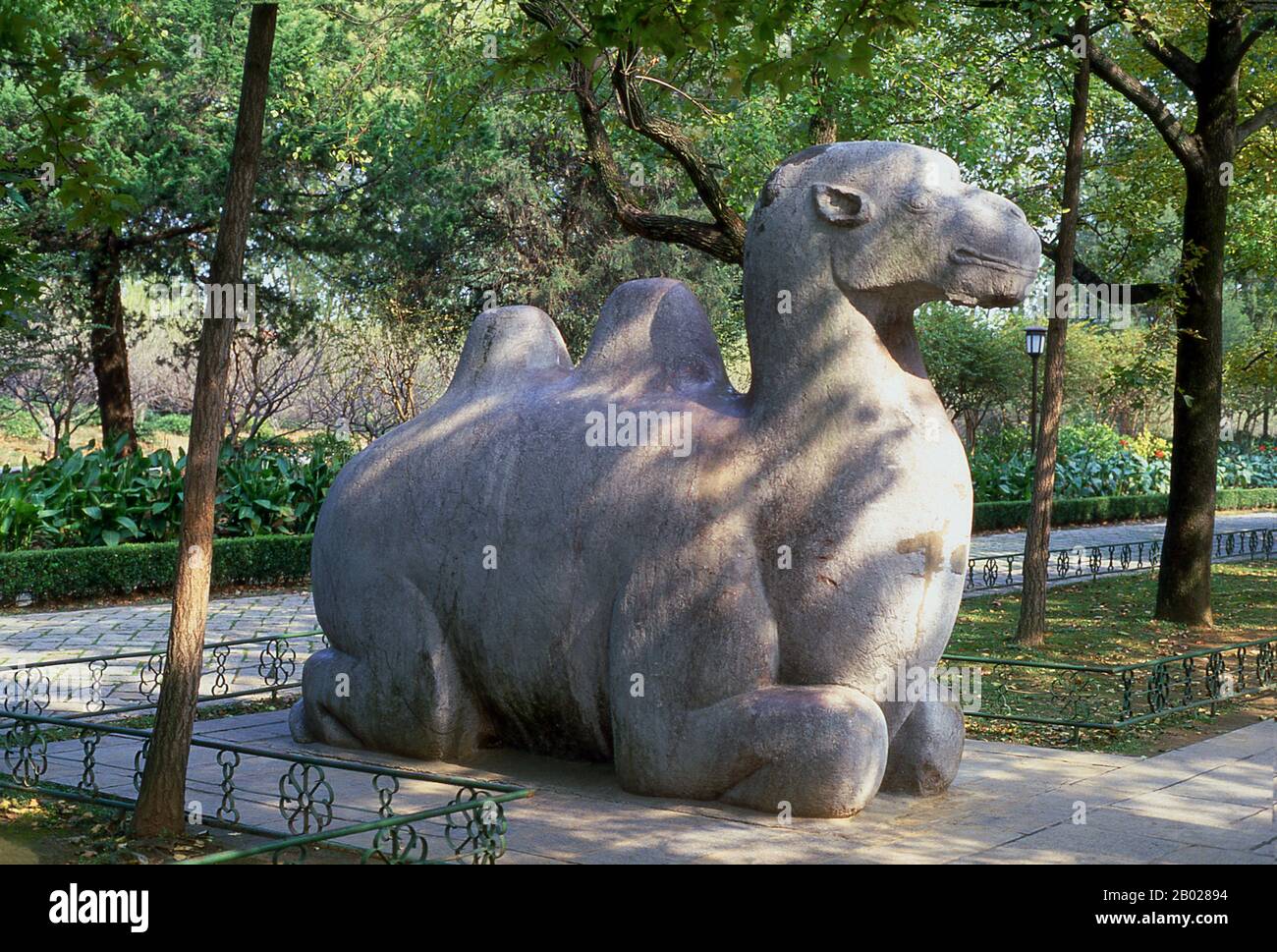 Emperor Hongwu, 1st ruler of the Ming Dynasty (r. 1368-1398). Personal Name: Zhu Yuanzhang, Zhū Yuánzhāng Posthumous Name: Gaodi, Gāodì Temple Name: Taizu, Tàizǔ Reign Name: Ming Hongwu, Ming Hóngwǔ The Hongwu Emperor was the founder and first emperor (1368–98) of the Ming Dynasty of China. His era name, Hongwu, means 'vastly martial'. In the middle of the 14th century, with famine, plagues and peasant revolts sweeping across China, Zhu became a leader of an army that conquered China, ending the Yuan Dynasty and forcing the Mongols to retreat to the Mongolian steppes. With his seizure of the Stock Photohttps://www.alamy.com/image-license-details/?v=1https://www.alamy.com/emperor-hongwu-1st-ruler-of-the-ming-dynasty-r-1368-1398-personal-name-zhu-yuanzhang-zh-yunzhng-posthumous-name-gaodi-god-temple-name-taizu-tiz-reign-name-ming-hongwu-ming-hngw-the-hongwu-emperor-was-the-founder-and-first-emperor-136898-of-the-ming-dynasty-of-china-his-era-name-hongwu-means-vastly-martial-in-the-middle-of-the-14th-century-with-famine-plagues-and-peasant-revolts-sweeping-across-china-zhu-became-a-leader-of-an-army-that-conquered-china-ending-the-yuan-dynasty-and-forcing-the-mongols-to-retreat-to-the-mongolian-steppes-with-his-seizure-of-the-image344257792.html
Emperor Hongwu, 1st ruler of the Ming Dynasty (r. 1368-1398). Personal Name: Zhu Yuanzhang, Zhū Yuánzhāng Posthumous Name: Gaodi, Gāodì Temple Name: Taizu, Tàizǔ Reign Name: Ming Hongwu, Ming Hóngwǔ The Hongwu Emperor was the founder and first emperor (1368–98) of the Ming Dynasty of China. His era name, Hongwu, means 'vastly martial'. In the middle of the 14th century, with famine, plagues and peasant revolts sweeping across China, Zhu became a leader of an army that conquered China, ending the Yuan Dynasty and forcing the Mongols to retreat to the Mongolian steppes. With his seizure of the Stock Photohttps://www.alamy.com/image-license-details/?v=1https://www.alamy.com/emperor-hongwu-1st-ruler-of-the-ming-dynasty-r-1368-1398-personal-name-zhu-yuanzhang-zh-yunzhng-posthumous-name-gaodi-god-temple-name-taizu-tiz-reign-name-ming-hongwu-ming-hngw-the-hongwu-emperor-was-the-founder-and-first-emperor-136898-of-the-ming-dynasty-of-china-his-era-name-hongwu-means-vastly-martial-in-the-middle-of-the-14th-century-with-famine-plagues-and-peasant-revolts-sweeping-across-china-zhu-became-a-leader-of-an-army-that-conquered-china-ending-the-yuan-dynasty-and-forcing-the-mongols-to-retreat-to-the-mongolian-steppes-with-his-seizure-of-the-image344257792.htmlRM2B02894–Emperor Hongwu, 1st ruler of the Ming Dynasty (r. 1368-1398). Personal Name: Zhu Yuanzhang, Zhū Yuánzhāng Posthumous Name: Gaodi, Gāodì Temple Name: Taizu, Tàizǔ Reign Name: Ming Hongwu, Ming Hóngwǔ The Hongwu Emperor was the founder and first emperor (1368–98) of the Ming Dynasty of China. His era name, Hongwu, means 'vastly martial'. In the middle of the 14th century, with famine, plagues and peasant revolts sweeping across China, Zhu became a leader of an army that conquered China, ending the Yuan Dynasty and forcing the Mongols to retreat to the Mongolian steppes. With his seizure of the
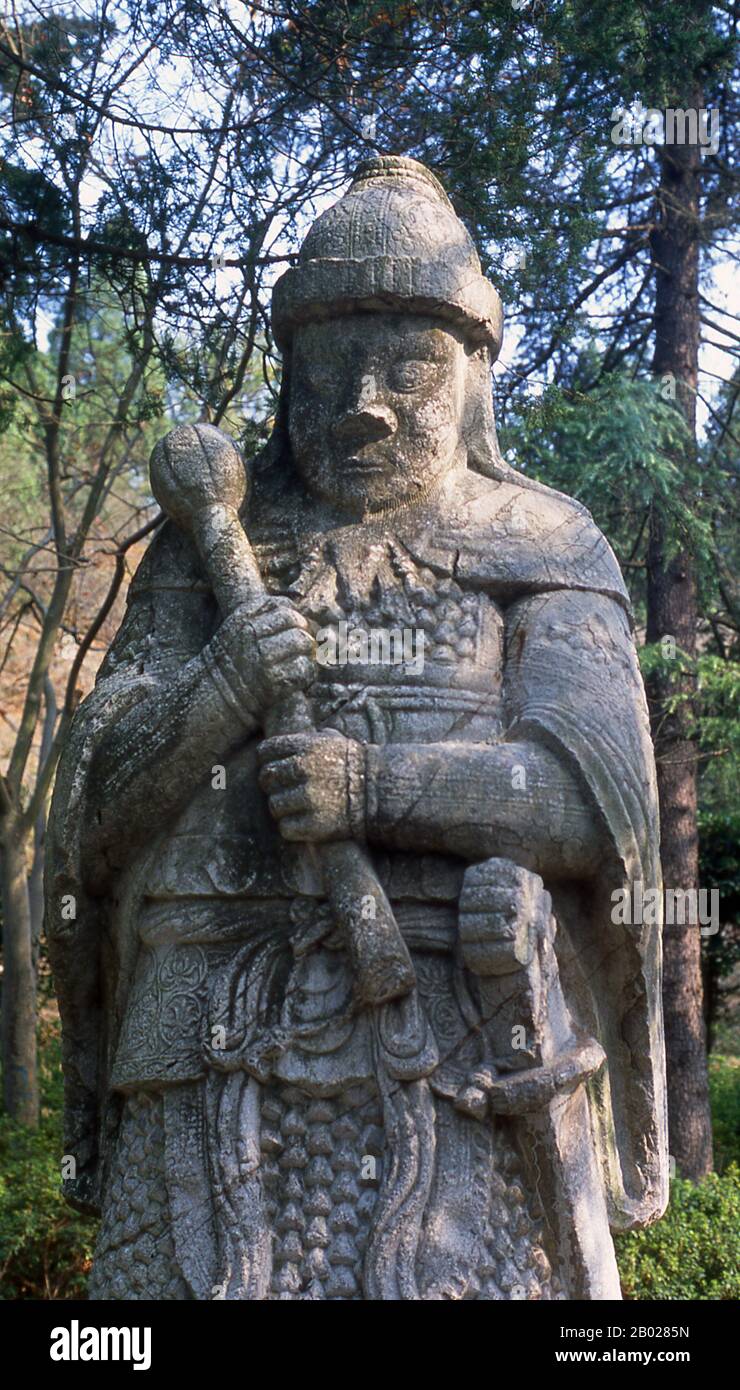 Emperor Hongwu, 1st ruler of the Ming Dynasty (r. 1368-1398). Personal Name: Zhu Yuanzhang, Zhū Yuánzhāng Posthumous Name: Gaodi, Gāodì Temple Name: Taizu, Tàizǔ Reign Name: Ming Hongwu, Ming Hóngwǔ The Hongwu Emperor was the founder and first emperor (1368–98) of the Ming Dynasty of China. His era name, Hongwu, means 'vastly martial'. In the middle of the 14th century, with famine, plagues and peasant revolts sweeping across China, Zhu became a leader of an army that conquered China, ending the Yuan Dynasty and forcing the Mongols to retreat to the Mongolian steppes. With his seizure of the Stock Photohttps://www.alamy.com/image-license-details/?v=1https://www.alamy.com/emperor-hongwu-1st-ruler-of-the-ming-dynasty-r-1368-1398-personal-name-zhu-yuanzhang-zh-yunzhng-posthumous-name-gaodi-god-temple-name-taizu-tiz-reign-name-ming-hongwu-ming-hngw-the-hongwu-emperor-was-the-founder-and-first-emperor-136898-of-the-ming-dynasty-of-china-his-era-name-hongwu-means-vastly-martial-in-the-middle-of-the-14th-century-with-famine-plagues-and-peasant-revolts-sweeping-across-china-zhu-became-a-leader-of-an-army-that-conquered-china-ending-the-yuan-dynasty-and-forcing-the-mongols-to-retreat-to-the-mongolian-steppes-with-his-seizure-of-the-image344257697.html
Emperor Hongwu, 1st ruler of the Ming Dynasty (r. 1368-1398). Personal Name: Zhu Yuanzhang, Zhū Yuánzhāng Posthumous Name: Gaodi, Gāodì Temple Name: Taizu, Tàizǔ Reign Name: Ming Hongwu, Ming Hóngwǔ The Hongwu Emperor was the founder and first emperor (1368–98) of the Ming Dynasty of China. His era name, Hongwu, means 'vastly martial'. In the middle of the 14th century, with famine, plagues and peasant revolts sweeping across China, Zhu became a leader of an army that conquered China, ending the Yuan Dynasty and forcing the Mongols to retreat to the Mongolian steppes. With his seizure of the Stock Photohttps://www.alamy.com/image-license-details/?v=1https://www.alamy.com/emperor-hongwu-1st-ruler-of-the-ming-dynasty-r-1368-1398-personal-name-zhu-yuanzhang-zh-yunzhng-posthumous-name-gaodi-god-temple-name-taizu-tiz-reign-name-ming-hongwu-ming-hngw-the-hongwu-emperor-was-the-founder-and-first-emperor-136898-of-the-ming-dynasty-of-china-his-era-name-hongwu-means-vastly-martial-in-the-middle-of-the-14th-century-with-famine-plagues-and-peasant-revolts-sweeping-across-china-zhu-became-a-leader-of-an-army-that-conquered-china-ending-the-yuan-dynasty-and-forcing-the-mongols-to-retreat-to-the-mongolian-steppes-with-his-seizure-of-the-image344257697.htmlRM2B0285N–Emperor Hongwu, 1st ruler of the Ming Dynasty (r. 1368-1398). Personal Name: Zhu Yuanzhang, Zhū Yuánzhāng Posthumous Name: Gaodi, Gāodì Temple Name: Taizu, Tàizǔ Reign Name: Ming Hongwu, Ming Hóngwǔ The Hongwu Emperor was the founder and first emperor (1368–98) of the Ming Dynasty of China. His era name, Hongwu, means 'vastly martial'. In the middle of the 14th century, with famine, plagues and peasant revolts sweeping across China, Zhu became a leader of an army that conquered China, ending the Yuan Dynasty and forcing the Mongols to retreat to the Mongolian steppes. With his seizure of the
 GUANGZHOU, CHINA - OCTOBER 24: This is a side street at Gaodi Old Street, a famous old street with traditional local shops on October 24, 2018 in Guan Stock Photohttps://www.alamy.com/image-license-details/?v=1https://www.alamy.com/guangzhou-china-october-24-this-is-a-side-street-at-gaodi-old-street-a-famous-old-street-with-traditional-local-shops-on-october-24-2018-in-guan-image336613602.html
GUANGZHOU, CHINA - OCTOBER 24: This is a side street at Gaodi Old Street, a famous old street with traditional local shops on October 24, 2018 in Guan Stock Photohttps://www.alamy.com/image-license-details/?v=1https://www.alamy.com/guangzhou-china-october-24-this-is-a-side-street-at-gaodi-old-street-a-famous-old-street-with-traditional-local-shops-on-october-24-2018-in-guan-image336613602.htmlRF2AFJ22A–GUANGZHOU, CHINA - OCTOBER 24: This is a side street at Gaodi Old Street, a famous old street with traditional local shops on October 24, 2018 in Guan
 Emperor Hongwu, 1st ruler of the Ming Dynasty (r. 1368-1398). Personal Name: Zhu Yuanzhang, Zhū Yuánzhāng Posthumous Name: Gaodi, Gāodì Temple Name: Taizu, Tàizǔ Reign Name: Ming Hongwu, Ming Hóngwǔ The Hongwu Emperor was the founder and first emperor (1368–98) of the Ming Dynasty of China. His era name, Hongwu, means 'vastly martial'. In the middle of the 14th century, with famine, plagues and peasant revolts sweeping across China, Zhu became a leader of an army that conquered China, ending the Yuan Dynasty and forcing the Mongols to retreat to the Mongolian steppes. With his seizure of the Stock Photohttps://www.alamy.com/image-license-details/?v=1https://www.alamy.com/emperor-hongwu-1st-ruler-of-the-ming-dynasty-r-1368-1398-personal-name-zhu-yuanzhang-zh-yunzhng-posthumous-name-gaodi-god-temple-name-taizu-tiz-reign-name-ming-hongwu-ming-hngw-the-hongwu-emperor-was-the-founder-and-first-emperor-136898-of-the-ming-dynasty-of-china-his-era-name-hongwu-means-vastly-martial-in-the-middle-of-the-14th-century-with-famine-plagues-and-peasant-revolts-sweeping-across-china-zhu-became-a-leader-of-an-army-that-conquered-china-ending-the-yuan-dynasty-and-forcing-the-mongols-to-retreat-to-the-mongolian-steppes-with-his-seizure-of-the-image344257699.html
Emperor Hongwu, 1st ruler of the Ming Dynasty (r. 1368-1398). Personal Name: Zhu Yuanzhang, Zhū Yuánzhāng Posthumous Name: Gaodi, Gāodì Temple Name: Taizu, Tàizǔ Reign Name: Ming Hongwu, Ming Hóngwǔ The Hongwu Emperor was the founder and first emperor (1368–98) of the Ming Dynasty of China. His era name, Hongwu, means 'vastly martial'. In the middle of the 14th century, with famine, plagues and peasant revolts sweeping across China, Zhu became a leader of an army that conquered China, ending the Yuan Dynasty and forcing the Mongols to retreat to the Mongolian steppes. With his seizure of the Stock Photohttps://www.alamy.com/image-license-details/?v=1https://www.alamy.com/emperor-hongwu-1st-ruler-of-the-ming-dynasty-r-1368-1398-personal-name-zhu-yuanzhang-zh-yunzhng-posthumous-name-gaodi-god-temple-name-taizu-tiz-reign-name-ming-hongwu-ming-hngw-the-hongwu-emperor-was-the-founder-and-first-emperor-136898-of-the-ming-dynasty-of-china-his-era-name-hongwu-means-vastly-martial-in-the-middle-of-the-14th-century-with-famine-plagues-and-peasant-revolts-sweeping-across-china-zhu-became-a-leader-of-an-army-that-conquered-china-ending-the-yuan-dynasty-and-forcing-the-mongols-to-retreat-to-the-mongolian-steppes-with-his-seizure-of-the-image344257699.htmlRM2B0285R–Emperor Hongwu, 1st ruler of the Ming Dynasty (r. 1368-1398). Personal Name: Zhu Yuanzhang, Zhū Yuánzhāng Posthumous Name: Gaodi, Gāodì Temple Name: Taizu, Tàizǔ Reign Name: Ming Hongwu, Ming Hóngwǔ The Hongwu Emperor was the founder and first emperor (1368–98) of the Ming Dynasty of China. His era name, Hongwu, means 'vastly martial'. In the middle of the 14th century, with famine, plagues and peasant revolts sweeping across China, Zhu became a leader of an army that conquered China, ending the Yuan Dynasty and forcing the Mongols to retreat to the Mongolian steppes. With his seizure of the
 GUANGZHOU, CHINA - OCTOBER 24: Chinese Workers pulling a cart in Gaodi Old street, an historic old street on October 24, 2018 in Guangzhou Stock Photohttps://www.alamy.com/image-license-details/?v=1https://www.alamy.com/guangzhou-china-october-24-chinese-workers-pulling-a-cart-in-gaodi-old-street-an-historic-old-street-on-october-24-2018-in-guangzhou-image240803568.html
GUANGZHOU, CHINA - OCTOBER 24: Chinese Workers pulling a cart in Gaodi Old street, an historic old street on October 24, 2018 in Guangzhou Stock Photohttps://www.alamy.com/image-license-details/?v=1https://www.alamy.com/guangzhou-china-october-24-chinese-workers-pulling-a-cart-in-gaodi-old-street-an-historic-old-street-on-october-24-2018-in-guangzhou-image240803568.htmlRFRYNFBC–GUANGZHOU, CHINA - OCTOBER 24: Chinese Workers pulling a cart in Gaodi Old street, an historic old street on October 24, 2018 in Guangzhou
 Emperor Hongwu, 1st ruler of the Ming Dynasty (r. 1368-1398). Personal Name: Zhu Yuanzhang, Zhū Yuánzhāng Posthumous Name: Gaodi, Gāodì Temple Name: Taizu, Tàizǔ Reign Name: Ming Hongwu, Ming Hóngwǔ The Hongwu Emperor was the founder and first emperor (1368–98) of the Ming Dynasty of China. His era name, Hongwu, means 'vastly martial'. In the middle of the 14th century, with famine, plagues and peasant revolts sweeping across China, Zhu became a leader of an army that conquered China, ending the Yuan Dynasty and forcing the Mongols to retreat to the Mongolian steppes. With his seizure of the Stock Photohttps://www.alamy.com/image-license-details/?v=1https://www.alamy.com/emperor-hongwu-1st-ruler-of-the-ming-dynasty-r-1368-1398-personal-name-zhu-yuanzhang-zh-yunzhng-posthumous-name-gaodi-god-temple-name-taizu-tiz-reign-name-ming-hongwu-ming-hngw-the-hongwu-emperor-was-the-founder-and-first-emperor-136898-of-the-ming-dynasty-of-china-his-era-name-hongwu-means-vastly-martial-in-the-middle-of-the-14th-century-with-famine-plagues-and-peasant-revolts-sweeping-across-china-zhu-became-a-leader-of-an-army-that-conquered-china-ending-the-yuan-dynasty-and-forcing-the-mongols-to-retreat-to-the-mongolian-steppes-with-his-seizure-of-the-image344257701.html
Emperor Hongwu, 1st ruler of the Ming Dynasty (r. 1368-1398). Personal Name: Zhu Yuanzhang, Zhū Yuánzhāng Posthumous Name: Gaodi, Gāodì Temple Name: Taizu, Tàizǔ Reign Name: Ming Hongwu, Ming Hóngwǔ The Hongwu Emperor was the founder and first emperor (1368–98) of the Ming Dynasty of China. His era name, Hongwu, means 'vastly martial'. In the middle of the 14th century, with famine, plagues and peasant revolts sweeping across China, Zhu became a leader of an army that conquered China, ending the Yuan Dynasty and forcing the Mongols to retreat to the Mongolian steppes. With his seizure of the Stock Photohttps://www.alamy.com/image-license-details/?v=1https://www.alamy.com/emperor-hongwu-1st-ruler-of-the-ming-dynasty-r-1368-1398-personal-name-zhu-yuanzhang-zh-yunzhng-posthumous-name-gaodi-god-temple-name-taizu-tiz-reign-name-ming-hongwu-ming-hngw-the-hongwu-emperor-was-the-founder-and-first-emperor-136898-of-the-ming-dynasty-of-china-his-era-name-hongwu-means-vastly-martial-in-the-middle-of-the-14th-century-with-famine-plagues-and-peasant-revolts-sweeping-across-china-zhu-became-a-leader-of-an-army-that-conquered-china-ending-the-yuan-dynasty-and-forcing-the-mongols-to-retreat-to-the-mongolian-steppes-with-his-seizure-of-the-image344257701.htmlRM2B0285W–Emperor Hongwu, 1st ruler of the Ming Dynasty (r. 1368-1398). Personal Name: Zhu Yuanzhang, Zhū Yuánzhāng Posthumous Name: Gaodi, Gāodì Temple Name: Taizu, Tàizǔ Reign Name: Ming Hongwu, Ming Hóngwǔ The Hongwu Emperor was the founder and first emperor (1368–98) of the Ming Dynasty of China. His era name, Hongwu, means 'vastly martial'. In the middle of the 14th century, with famine, plagues and peasant revolts sweeping across China, Zhu became a leader of an army that conquered China, ending the Yuan Dynasty and forcing the Mongols to retreat to the Mongolian steppes. With his seizure of the
 Emperor Hongwu, 1st ruler of the Ming Dynasty (r. 1368-1398). Personal Name: Zhu Yuanzhang, Zhū Yuánzhāng Posthumous Name: Gaodi, Gāodì Temple Name: Taizu, Tàizǔ Reign Name: Ming Hongwu, Ming Hóngwǔ The Hongwu Emperor was the founder and first emperor (1368–98) of the Ming Dynasty of China. His era name, Hongwu, means 'vastly martial'. In the middle of the 14th century, with famine, plagues and peasant revolts sweeping across China, Zhu became a leader of an army that conquered China, ending the Yuan Dynasty and forcing the Mongols to retreat to the Mongolian steppes. With his seizure of the Stock Photohttps://www.alamy.com/image-license-details/?v=1https://www.alamy.com/emperor-hongwu-1st-ruler-of-the-ming-dynasty-r-1368-1398-personal-name-zhu-yuanzhang-zh-yunzhng-posthumous-name-gaodi-god-temple-name-taizu-tiz-reign-name-ming-hongwu-ming-hngw-the-hongwu-emperor-was-the-founder-and-first-emperor-136898-of-the-ming-dynasty-of-china-his-era-name-hongwu-means-vastly-martial-in-the-middle-of-the-14th-century-with-famine-plagues-and-peasant-revolts-sweeping-across-china-zhu-became-a-leader-of-an-army-that-conquered-china-ending-the-yuan-dynasty-and-forcing-the-mongols-to-retreat-to-the-mongolian-steppes-with-his-seizure-of-the-image344257698.html
Emperor Hongwu, 1st ruler of the Ming Dynasty (r. 1368-1398). Personal Name: Zhu Yuanzhang, Zhū Yuánzhāng Posthumous Name: Gaodi, Gāodì Temple Name: Taizu, Tàizǔ Reign Name: Ming Hongwu, Ming Hóngwǔ The Hongwu Emperor was the founder and first emperor (1368–98) of the Ming Dynasty of China. His era name, Hongwu, means 'vastly martial'. In the middle of the 14th century, with famine, plagues and peasant revolts sweeping across China, Zhu became a leader of an army that conquered China, ending the Yuan Dynasty and forcing the Mongols to retreat to the Mongolian steppes. With his seizure of the Stock Photohttps://www.alamy.com/image-license-details/?v=1https://www.alamy.com/emperor-hongwu-1st-ruler-of-the-ming-dynasty-r-1368-1398-personal-name-zhu-yuanzhang-zh-yunzhng-posthumous-name-gaodi-god-temple-name-taizu-tiz-reign-name-ming-hongwu-ming-hngw-the-hongwu-emperor-was-the-founder-and-first-emperor-136898-of-the-ming-dynasty-of-china-his-era-name-hongwu-means-vastly-martial-in-the-middle-of-the-14th-century-with-famine-plagues-and-peasant-revolts-sweeping-across-china-zhu-became-a-leader-of-an-army-that-conquered-china-ending-the-yuan-dynasty-and-forcing-the-mongols-to-retreat-to-the-mongolian-steppes-with-his-seizure-of-the-image344257698.htmlRM2B0285P–Emperor Hongwu, 1st ruler of the Ming Dynasty (r. 1368-1398). Personal Name: Zhu Yuanzhang, Zhū Yuánzhāng Posthumous Name: Gaodi, Gāodì Temple Name: Taizu, Tàizǔ Reign Name: Ming Hongwu, Ming Hóngwǔ The Hongwu Emperor was the founder and first emperor (1368–98) of the Ming Dynasty of China. His era name, Hongwu, means 'vastly martial'. In the middle of the 14th century, with famine, plagues and peasant revolts sweeping across China, Zhu became a leader of an army that conquered China, ending the Yuan Dynasty and forcing the Mongols to retreat to the Mongolian steppes. With his seizure of the
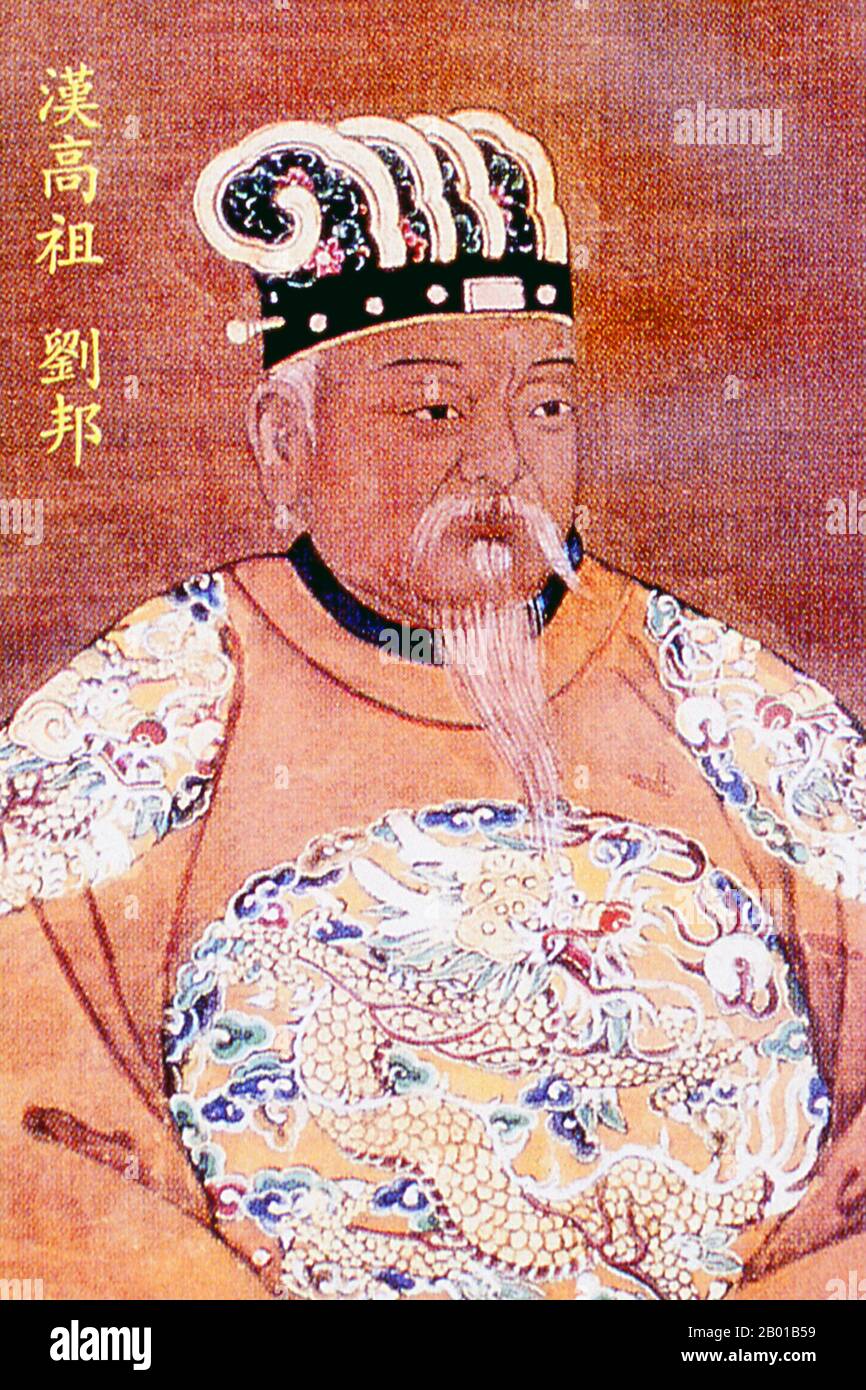 China: Emperor Gaozu (256/247 BCE - 1 June 195 BCE), founder and first ruler of the Western Han Dynasty (206 BCE-9 CE). Ming Dynasty hanging scroll painting, 1368-1644. Emperor Gaozu, personal name Liu Bang, courtesy name Ji, temple name Taizu and posthumous name Gaodi, was the founder of the Han Dynasty, ruling over China from 202 BCE to 195 BCE. Liu was one of the few dynastic founders in Chinese history who emerged from the peasant class (another major example being Zhu Yuanzhang of the Ming Dynasty). In the early stage of his rise to prominence, Liu was addressed as 'Duke of Pei'. Stock Photohttps://www.alamy.com/image-license-details/?v=1https://www.alamy.com/china-emperor-gaozu-256247-bce-1-june-195-bce-founder-and-first-ruler-of-the-western-han-dynasty-206-bce-9-ce-ming-dynasty-hanging-scroll-painting-1368-1644-emperor-gaozu-personal-name-liu-bang-courtesy-name-ji-temple-name-taizu-and-posthumous-name-gaodi-was-the-founder-of-the-han-dynasty-ruling-over-china-from-202-bce-to-195-bce-liu-was-one-of-the-few-dynastic-founders-in-chinese-history-who-emerged-from-the-peasant-class-another-major-example-being-zhu-yuanzhang-of-the-ming-dynasty-in-the-early-stage-of-his-rise-to-prominence-liu-was-addressed-as-duke-of-pei-image344238085.html
China: Emperor Gaozu (256/247 BCE - 1 June 195 BCE), founder and first ruler of the Western Han Dynasty (206 BCE-9 CE). Ming Dynasty hanging scroll painting, 1368-1644. Emperor Gaozu, personal name Liu Bang, courtesy name Ji, temple name Taizu and posthumous name Gaodi, was the founder of the Han Dynasty, ruling over China from 202 BCE to 195 BCE. Liu was one of the few dynastic founders in Chinese history who emerged from the peasant class (another major example being Zhu Yuanzhang of the Ming Dynasty). In the early stage of his rise to prominence, Liu was addressed as 'Duke of Pei'. Stock Photohttps://www.alamy.com/image-license-details/?v=1https://www.alamy.com/china-emperor-gaozu-256247-bce-1-june-195-bce-founder-and-first-ruler-of-the-western-han-dynasty-206-bce-9-ce-ming-dynasty-hanging-scroll-painting-1368-1644-emperor-gaozu-personal-name-liu-bang-courtesy-name-ji-temple-name-taizu-and-posthumous-name-gaodi-was-the-founder-of-the-han-dynasty-ruling-over-china-from-202-bce-to-195-bce-liu-was-one-of-the-few-dynastic-founders-in-chinese-history-who-emerged-from-the-peasant-class-another-major-example-being-zhu-yuanzhang-of-the-ming-dynasty-in-the-early-stage-of-his-rise-to-prominence-liu-was-addressed-as-duke-of-pei-image344238085.htmlRM2B01B59–China: Emperor Gaozu (256/247 BCE - 1 June 195 BCE), founder and first ruler of the Western Han Dynasty (206 BCE-9 CE). Ming Dynasty hanging scroll painting, 1368-1644. Emperor Gaozu, personal name Liu Bang, courtesy name Ji, temple name Taizu and posthumous name Gaodi, was the founder of the Han Dynasty, ruling over China from 202 BCE to 195 BCE. Liu was one of the few dynastic founders in Chinese history who emerged from the peasant class (another major example being Zhu Yuanzhang of the Ming Dynasty). In the early stage of his rise to prominence, Liu was addressed as 'Duke of Pei'.
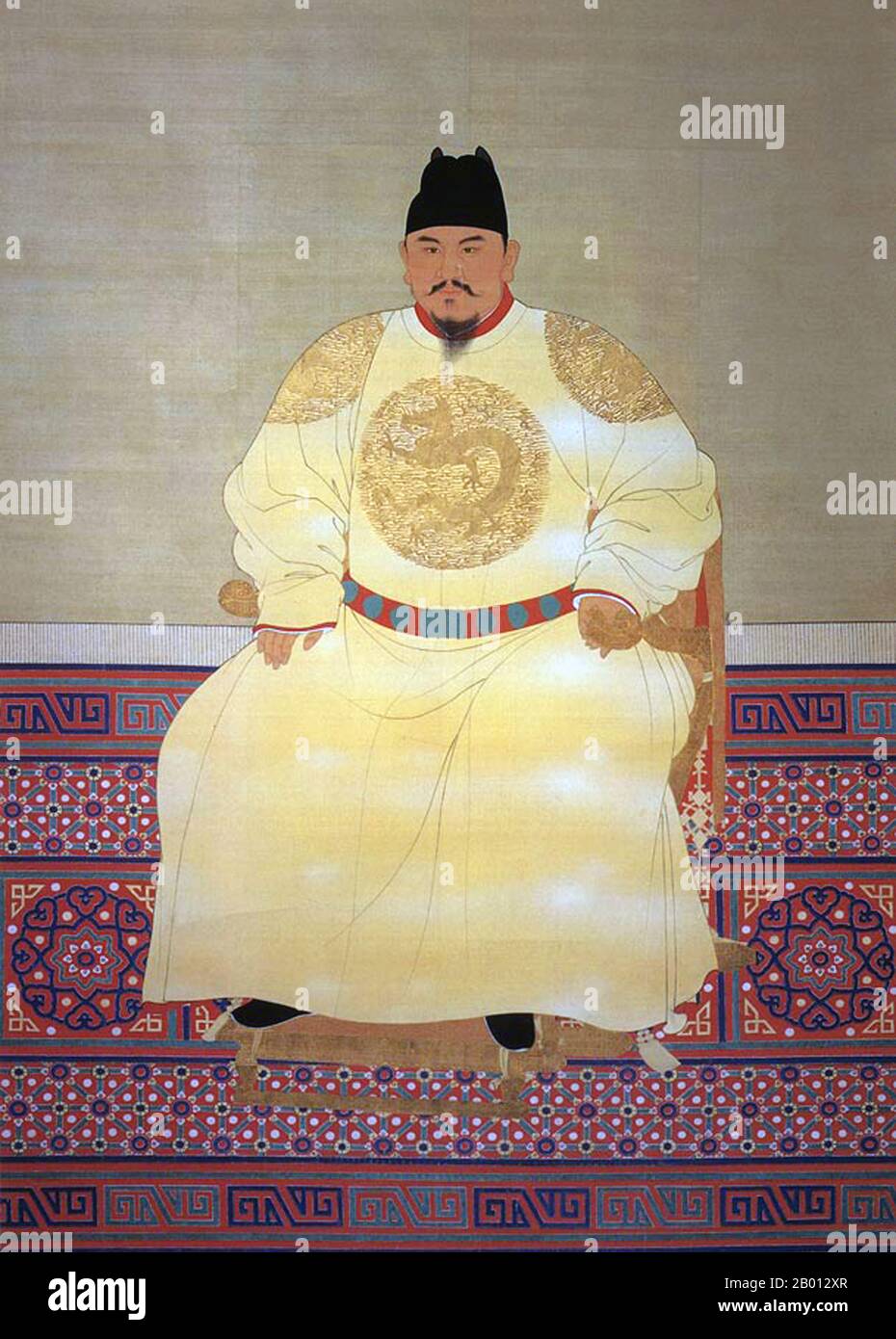 China: Emperor Hongwu, 1st ruler of the Ming Dynasty (r. 1368-1398). The Hongwu Emperor, personal name Zhu Yuanzhang and temple name Taizu, was the founder and first emperor (1368–98) of the Ming Dynasty of China. His era name, Hongwu, means 'vastly martial'. In the middle of the 14th century, with famine, plagues and peasant revolts sweeping across China, Zhu became a leader of an army that conquered China, ending the Yuan Dynasty and forcing the Mongols to retreat to the Mongolian steppes. With his seizure of the Yuan capital (present-day Beijing), he claimed the Mandate of Heaven. Stock Photohttps://www.alamy.com/image-license-details/?v=1https://www.alamy.com/china-emperor-hongwu-1st-ruler-of-the-ming-dynasty-r-1368-1398-the-hongwu-emperor-personal-name-zhu-yuanzhang-and-temple-name-taizu-was-the-founder-and-first-emperor-136898-of-the-ming-dynasty-of-china-his-era-name-hongwu-means-vastly-martial-in-the-middle-of-the-14th-century-with-famine-plagues-and-peasant-revolts-sweeping-across-china-zhu-became-a-leader-of-an-army-that-conquered-china-ending-the-yuan-dynasty-and-forcing-the-mongols-to-retreat-to-the-mongolian-steppes-with-his-seizure-of-the-yuan-capital-present-day-beijing-he-claimed-the-mandate-of-heaven-image344231631.html
China: Emperor Hongwu, 1st ruler of the Ming Dynasty (r. 1368-1398). The Hongwu Emperor, personal name Zhu Yuanzhang and temple name Taizu, was the founder and first emperor (1368–98) of the Ming Dynasty of China. His era name, Hongwu, means 'vastly martial'. In the middle of the 14th century, with famine, plagues and peasant revolts sweeping across China, Zhu became a leader of an army that conquered China, ending the Yuan Dynasty and forcing the Mongols to retreat to the Mongolian steppes. With his seizure of the Yuan capital (present-day Beijing), he claimed the Mandate of Heaven. Stock Photohttps://www.alamy.com/image-license-details/?v=1https://www.alamy.com/china-emperor-hongwu-1st-ruler-of-the-ming-dynasty-r-1368-1398-the-hongwu-emperor-personal-name-zhu-yuanzhang-and-temple-name-taizu-was-the-founder-and-first-emperor-136898-of-the-ming-dynasty-of-china-his-era-name-hongwu-means-vastly-martial-in-the-middle-of-the-14th-century-with-famine-plagues-and-peasant-revolts-sweeping-across-china-zhu-became-a-leader-of-an-army-that-conquered-china-ending-the-yuan-dynasty-and-forcing-the-mongols-to-retreat-to-the-mongolian-steppes-with-his-seizure-of-the-yuan-capital-present-day-beijing-he-claimed-the-mandate-of-heaven-image344231631.htmlRM2B012XR–China: Emperor Hongwu, 1st ruler of the Ming Dynasty (r. 1368-1398). The Hongwu Emperor, personal name Zhu Yuanzhang and temple name Taizu, was the founder and first emperor (1368–98) of the Ming Dynasty of China. His era name, Hongwu, means 'vastly martial'. In the middle of the 14th century, with famine, plagues and peasant revolts sweeping across China, Zhu became a leader of an army that conquered China, ending the Yuan Dynasty and forcing the Mongols to retreat to the Mongolian steppes. With his seizure of the Yuan capital (present-day Beijing), he claimed the Mandate of Heaven.
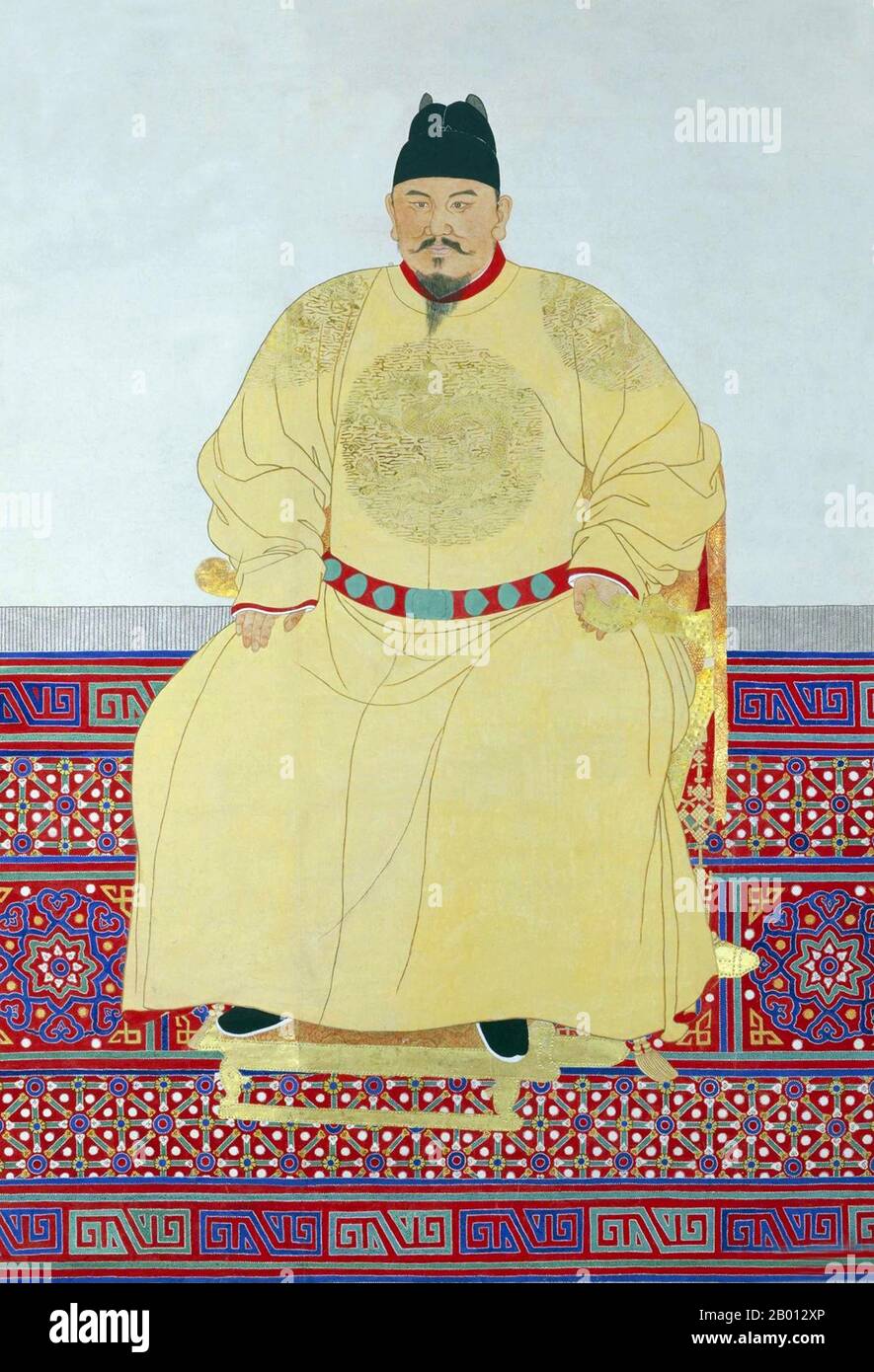 China: Emperor Hongwu, 1st ruler of the Ming Dynasty (r. 1368-1398). The Hongwu Emperor, personal name Zhu Yuanzhang and temple name Taizu, was the founder and first emperor (1368–98) of the Ming Dynasty of China. His era name, Hongwu, means 'vastly martial'. In the middle of the 14th century, with famine, plagues and peasant revolts sweeping across China, Zhu became a leader of an army that conquered China, ending the Yuan Dynasty and forcing the Mongols to retreat to the Mongolian steppes. With his seizure of the Yuan capital (present-day Beijing), he claimed the Mandate of Heaven. Stock Photohttps://www.alamy.com/image-license-details/?v=1https://www.alamy.com/china-emperor-hongwu-1st-ruler-of-the-ming-dynasty-r-1368-1398-the-hongwu-emperor-personal-name-zhu-yuanzhang-and-temple-name-taizu-was-the-founder-and-first-emperor-136898-of-the-ming-dynasty-of-china-his-era-name-hongwu-means-vastly-martial-in-the-middle-of-the-14th-century-with-famine-plagues-and-peasant-revolts-sweeping-across-china-zhu-became-a-leader-of-an-army-that-conquered-china-ending-the-yuan-dynasty-and-forcing-the-mongols-to-retreat-to-the-mongolian-steppes-with-his-seizure-of-the-yuan-capital-present-day-beijing-he-claimed-the-mandate-of-heaven-image344231630.html
China: Emperor Hongwu, 1st ruler of the Ming Dynasty (r. 1368-1398). The Hongwu Emperor, personal name Zhu Yuanzhang and temple name Taizu, was the founder and first emperor (1368–98) of the Ming Dynasty of China. His era name, Hongwu, means 'vastly martial'. In the middle of the 14th century, with famine, plagues and peasant revolts sweeping across China, Zhu became a leader of an army that conquered China, ending the Yuan Dynasty and forcing the Mongols to retreat to the Mongolian steppes. With his seizure of the Yuan capital (present-day Beijing), he claimed the Mandate of Heaven. Stock Photohttps://www.alamy.com/image-license-details/?v=1https://www.alamy.com/china-emperor-hongwu-1st-ruler-of-the-ming-dynasty-r-1368-1398-the-hongwu-emperor-personal-name-zhu-yuanzhang-and-temple-name-taizu-was-the-founder-and-first-emperor-136898-of-the-ming-dynasty-of-china-his-era-name-hongwu-means-vastly-martial-in-the-middle-of-the-14th-century-with-famine-plagues-and-peasant-revolts-sweeping-across-china-zhu-became-a-leader-of-an-army-that-conquered-china-ending-the-yuan-dynasty-and-forcing-the-mongols-to-retreat-to-the-mongolian-steppes-with-his-seizure-of-the-yuan-capital-present-day-beijing-he-claimed-the-mandate-of-heaven-image344231630.htmlRM2B012XP–China: Emperor Hongwu, 1st ruler of the Ming Dynasty (r. 1368-1398). The Hongwu Emperor, personal name Zhu Yuanzhang and temple name Taizu, was the founder and first emperor (1368–98) of the Ming Dynasty of China. His era name, Hongwu, means 'vastly martial'. In the middle of the 14th century, with famine, plagues and peasant revolts sweeping across China, Zhu became a leader of an army that conquered China, ending the Yuan Dynasty and forcing the Mongols to retreat to the Mongolian steppes. With his seizure of the Yuan capital (present-day Beijing), he claimed the Mandate of Heaven.
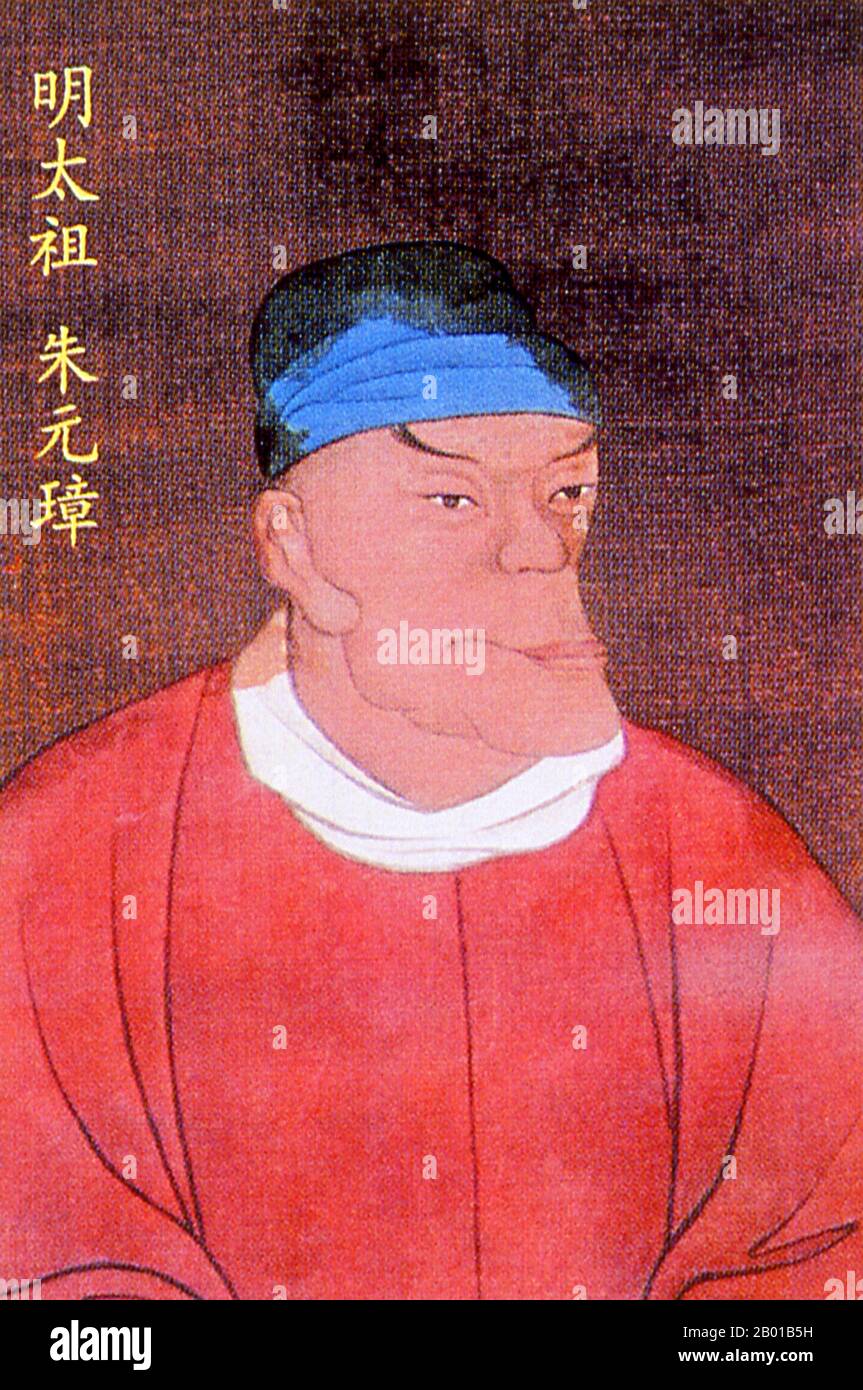 China: Emperor Hongwu (21 October 1328 - 24 June 1398), 1st ruler of the Ming Dynasty (r. 1368-1398). Ming Dynasty hanging scroll painting, 1368-1644. Emperor Hongwu, personal name Zhu Yuanzhang, courtesy name Guorui and temple name Taizu, was the founder of the Ming Dynasty. His era name, Hongwu, means 'vastly martial'. In the middle of the 14th century, with famine, plagues and peasant revolts sweeping across China, he became leader of the Red Turban forces that conquered China, ending the Yuan Dynasty and forcing the Mongols to retreat to the Mongolian steppes. Stock Photohttps://www.alamy.com/image-license-details/?v=1https://www.alamy.com/china-emperor-hongwu-21-october-1328-24-june-1398-1st-ruler-of-the-ming-dynasty-r-1368-1398-ming-dynasty-hanging-scroll-painting-1368-1644-emperor-hongwu-personal-name-zhu-yuanzhang-courtesy-name-guorui-and-temple-name-taizu-was-the-founder-of-the-ming-dynasty-his-era-name-hongwu-means-vastly-martial-in-the-middle-of-the-14th-century-with-famine-plagues-and-peasant-revolts-sweeping-across-china-he-became-leader-of-the-red-turban-forces-that-conquered-china-ending-the-yuan-dynasty-and-forcing-the-mongols-to-retreat-to-the-mongolian-steppes-image344238093.html
China: Emperor Hongwu (21 October 1328 - 24 June 1398), 1st ruler of the Ming Dynasty (r. 1368-1398). Ming Dynasty hanging scroll painting, 1368-1644. Emperor Hongwu, personal name Zhu Yuanzhang, courtesy name Guorui and temple name Taizu, was the founder of the Ming Dynasty. His era name, Hongwu, means 'vastly martial'. In the middle of the 14th century, with famine, plagues and peasant revolts sweeping across China, he became leader of the Red Turban forces that conquered China, ending the Yuan Dynasty and forcing the Mongols to retreat to the Mongolian steppes. Stock Photohttps://www.alamy.com/image-license-details/?v=1https://www.alamy.com/china-emperor-hongwu-21-october-1328-24-june-1398-1st-ruler-of-the-ming-dynasty-r-1368-1398-ming-dynasty-hanging-scroll-painting-1368-1644-emperor-hongwu-personal-name-zhu-yuanzhang-courtesy-name-guorui-and-temple-name-taizu-was-the-founder-of-the-ming-dynasty-his-era-name-hongwu-means-vastly-martial-in-the-middle-of-the-14th-century-with-famine-plagues-and-peasant-revolts-sweeping-across-china-he-became-leader-of-the-red-turban-forces-that-conquered-china-ending-the-yuan-dynasty-and-forcing-the-mongols-to-retreat-to-the-mongolian-steppes-image344238093.htmlRM2B01B5H–China: Emperor Hongwu (21 October 1328 - 24 June 1398), 1st ruler of the Ming Dynasty (r. 1368-1398). Ming Dynasty hanging scroll painting, 1368-1644. Emperor Hongwu, personal name Zhu Yuanzhang, courtesy name Guorui and temple name Taizu, was the founder of the Ming Dynasty. His era name, Hongwu, means 'vastly martial'. In the middle of the 14th century, with famine, plagues and peasant revolts sweeping across China, he became leader of the Red Turban forces that conquered China, ending the Yuan Dynasty and forcing the Mongols to retreat to the Mongolian steppes.
 China: Emperor Nurhaci (21 February 1559 - 30 September 1626), Jurchen chieftain and founding khan of the Later Jin Dynasty (r. 1616-1626). Hanging scroll painting, 17th century. Nurhaci/Nurhachi, temple name Taizu and era name Tianming, was an important Manchu chieftain who rose to prominence in the late 16th century in Northeastern China. He was part of the Aisin Gioro clan, and he united various Manchu tribes, consolidating the Eight Banners military system and eventually launching an assault on China's Ming Dynasty and Korea's Joseon Dynasty. His heirs founded the Qing Dynasty in 1644. Stock Photohttps://www.alamy.com/image-license-details/?v=1https://www.alamy.com/china-emperor-nurhaci-21-february-1559-30-september-1626-jurchen-chieftain-and-founding-khan-of-the-later-jin-dynasty-r-1616-1626-hanging-scroll-painting-17th-century-nurhacinurhachi-temple-name-taizu-and-era-name-tianming-was-an-important-manchu-chieftain-who-rose-to-prominence-in-the-late-16th-century-in-northeastern-china-he-was-part-of-the-aisin-gioro-clan-and-he-united-various-manchu-tribes-consolidating-the-eight-banners-military-system-and-eventually-launching-an-assault-on-chinas-ming-dynasty-and-koreas-joseon-dynasty-his-heirs-founded-the-qing-dynasty-in-1644-image344238095.html
China: Emperor Nurhaci (21 February 1559 - 30 September 1626), Jurchen chieftain and founding khan of the Later Jin Dynasty (r. 1616-1626). Hanging scroll painting, 17th century. Nurhaci/Nurhachi, temple name Taizu and era name Tianming, was an important Manchu chieftain who rose to prominence in the late 16th century in Northeastern China. He was part of the Aisin Gioro clan, and he united various Manchu tribes, consolidating the Eight Banners military system and eventually launching an assault on China's Ming Dynasty and Korea's Joseon Dynasty. His heirs founded the Qing Dynasty in 1644. Stock Photohttps://www.alamy.com/image-license-details/?v=1https://www.alamy.com/china-emperor-nurhaci-21-february-1559-30-september-1626-jurchen-chieftain-and-founding-khan-of-the-later-jin-dynasty-r-1616-1626-hanging-scroll-painting-17th-century-nurhacinurhachi-temple-name-taizu-and-era-name-tianming-was-an-important-manchu-chieftain-who-rose-to-prominence-in-the-late-16th-century-in-northeastern-china-he-was-part-of-the-aisin-gioro-clan-and-he-united-various-manchu-tribes-consolidating-the-eight-banners-military-system-and-eventually-launching-an-assault-on-chinas-ming-dynasty-and-koreas-joseon-dynasty-his-heirs-founded-the-qing-dynasty-in-1644-image344238095.htmlRM2B01B5K–China: Emperor Nurhaci (21 February 1559 - 30 September 1626), Jurchen chieftain and founding khan of the Later Jin Dynasty (r. 1616-1626). Hanging scroll painting, 17th century. Nurhaci/Nurhachi, temple name Taizu and era name Tianming, was an important Manchu chieftain who rose to prominence in the late 16th century in Northeastern China. He was part of the Aisin Gioro clan, and he united various Manchu tribes, consolidating the Eight Banners military system and eventually launching an assault on China's Ming Dynasty and Korea's Joseon Dynasty. His heirs founded the Qing Dynasty in 1644.
 China: Emperor Hongwu, 1st ruler of the Ming Dynasty (r. 1368-1398). Handscroll painting, Qing Dynasty. The Hongwu Emperor, personal name Zhu Yuanzhang and temple name Taizu, was the founder and first emperor (1368–98) of the Ming Dynasty of China. His era name, Hongwu, means 'vastly martial'. In the middle of the 14th century, with famine, plagues and peasant revolts sweeping across China, Zhu became a leader of an army that conquered China, ending the Yuan Dynasty and forcing the Mongols to retreat to the Mongolian steppes. Stock Photohttps://www.alamy.com/image-license-details/?v=1https://www.alamy.com/china-emperor-hongwu-1st-ruler-of-the-ming-dynasty-r-1368-1398-handscroll-painting-qing-dynasty-the-hongwu-emperor-personal-name-zhu-yuanzhang-and-temple-name-taizu-was-the-founder-and-first-emperor-136898-of-the-ming-dynasty-of-china-his-era-name-hongwu-means-vastly-martial-in-the-middle-of-the-14th-century-with-famine-plagues-and-peasant-revolts-sweeping-across-china-zhu-became-a-leader-of-an-army-that-conquered-china-ending-the-yuan-dynasty-and-forcing-the-mongols-to-retreat-to-the-mongolian-steppes-image344231628.html
China: Emperor Hongwu, 1st ruler of the Ming Dynasty (r. 1368-1398). Handscroll painting, Qing Dynasty. The Hongwu Emperor, personal name Zhu Yuanzhang and temple name Taizu, was the founder and first emperor (1368–98) of the Ming Dynasty of China. His era name, Hongwu, means 'vastly martial'. In the middle of the 14th century, with famine, plagues and peasant revolts sweeping across China, Zhu became a leader of an army that conquered China, ending the Yuan Dynasty and forcing the Mongols to retreat to the Mongolian steppes. Stock Photohttps://www.alamy.com/image-license-details/?v=1https://www.alamy.com/china-emperor-hongwu-1st-ruler-of-the-ming-dynasty-r-1368-1398-handscroll-painting-qing-dynasty-the-hongwu-emperor-personal-name-zhu-yuanzhang-and-temple-name-taizu-was-the-founder-and-first-emperor-136898-of-the-ming-dynasty-of-china-his-era-name-hongwu-means-vastly-martial-in-the-middle-of-the-14th-century-with-famine-plagues-and-peasant-revolts-sweeping-across-china-zhu-became-a-leader-of-an-army-that-conquered-china-ending-the-yuan-dynasty-and-forcing-the-mongols-to-retreat-to-the-mongolian-steppes-image344231628.htmlRM2B012XM–China: Emperor Hongwu, 1st ruler of the Ming Dynasty (r. 1368-1398). Handscroll painting, Qing Dynasty. The Hongwu Emperor, personal name Zhu Yuanzhang and temple name Taizu, was the founder and first emperor (1368–98) of the Ming Dynasty of China. His era name, Hongwu, means 'vastly martial'. In the middle of the 14th century, with famine, plagues and peasant revolts sweeping across China, Zhu became a leader of an army that conquered China, ending the Yuan Dynasty and forcing the Mongols to retreat to the Mongolian steppes.
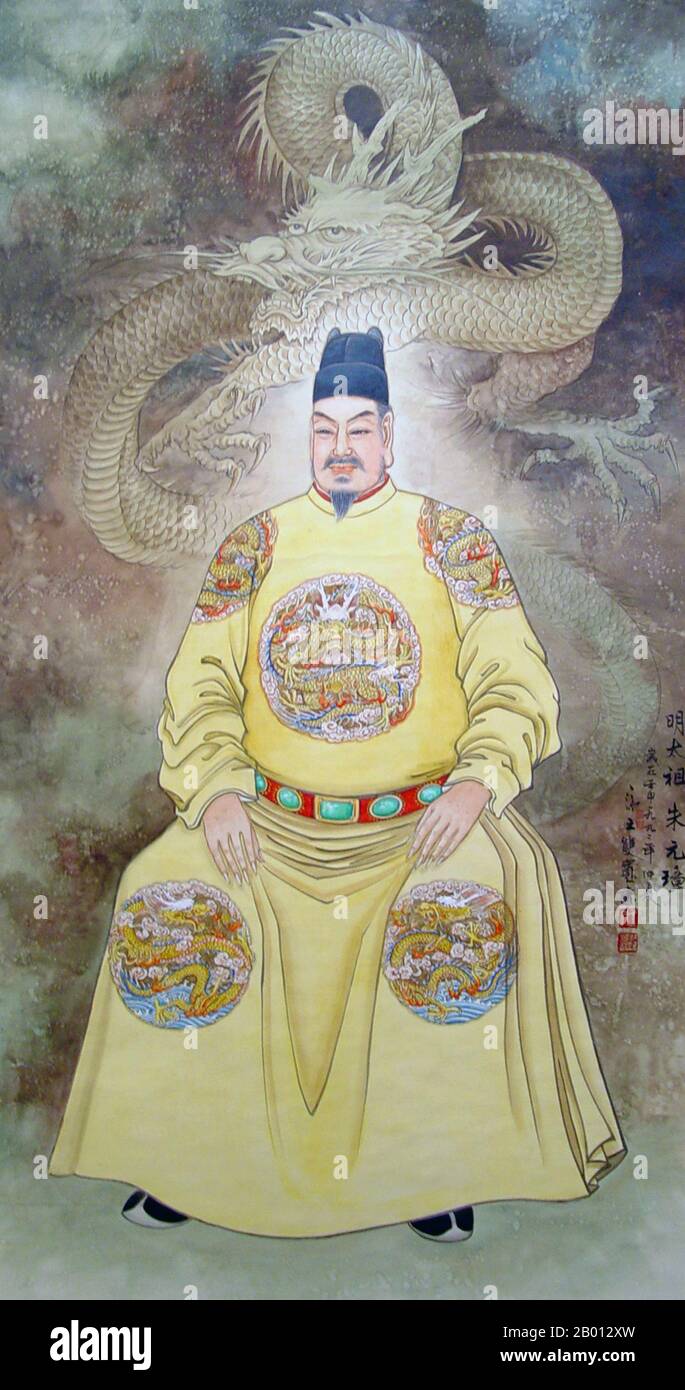 China: Emperor Hongwu, 1st ruler of the Ming Dynasty (r. 1368-1398). The Hongwu Emperor, personal name Zhu Yuanzhang and temple name Taizu, was the founder and first emperor (1368–98) of the Ming Dynasty of China. His era name, Hongwu, means 'vastly martial'. In the middle of the 14th century, with famine, plagues and peasant revolts sweeping across China, Zhu became a leader of an army that conquered China, ending the Yuan Dynasty and forcing the Mongols to retreat to the Mongolian steppes. With his seizure of the Yuan capital (present-day Beijing), he claimed the Mandate of Heaven. Stock Photohttps://www.alamy.com/image-license-details/?v=1https://www.alamy.com/china-emperor-hongwu-1st-ruler-of-the-ming-dynasty-r-1368-1398-the-hongwu-emperor-personal-name-zhu-yuanzhang-and-temple-name-taizu-was-the-founder-and-first-emperor-136898-of-the-ming-dynasty-of-china-his-era-name-hongwu-means-vastly-martial-in-the-middle-of-the-14th-century-with-famine-plagues-and-peasant-revolts-sweeping-across-china-zhu-became-a-leader-of-an-army-that-conquered-china-ending-the-yuan-dynasty-and-forcing-the-mongols-to-retreat-to-the-mongolian-steppes-with-his-seizure-of-the-yuan-capital-present-day-beijing-he-claimed-the-mandate-of-heaven-image344231633.html
China: Emperor Hongwu, 1st ruler of the Ming Dynasty (r. 1368-1398). The Hongwu Emperor, personal name Zhu Yuanzhang and temple name Taizu, was the founder and first emperor (1368–98) of the Ming Dynasty of China. His era name, Hongwu, means 'vastly martial'. In the middle of the 14th century, with famine, plagues and peasant revolts sweeping across China, Zhu became a leader of an army that conquered China, ending the Yuan Dynasty and forcing the Mongols to retreat to the Mongolian steppes. With his seizure of the Yuan capital (present-day Beijing), he claimed the Mandate of Heaven. Stock Photohttps://www.alamy.com/image-license-details/?v=1https://www.alamy.com/china-emperor-hongwu-1st-ruler-of-the-ming-dynasty-r-1368-1398-the-hongwu-emperor-personal-name-zhu-yuanzhang-and-temple-name-taizu-was-the-founder-and-first-emperor-136898-of-the-ming-dynasty-of-china-his-era-name-hongwu-means-vastly-martial-in-the-middle-of-the-14th-century-with-famine-plagues-and-peasant-revolts-sweeping-across-china-zhu-became-a-leader-of-an-army-that-conquered-china-ending-the-yuan-dynasty-and-forcing-the-mongols-to-retreat-to-the-mongolian-steppes-with-his-seizure-of-the-yuan-capital-present-day-beijing-he-claimed-the-mandate-of-heaven-image344231633.htmlRM2B012XW–China: Emperor Hongwu, 1st ruler of the Ming Dynasty (r. 1368-1398). The Hongwu Emperor, personal name Zhu Yuanzhang and temple name Taizu, was the founder and first emperor (1368–98) of the Ming Dynasty of China. His era name, Hongwu, means 'vastly martial'. In the middle of the 14th century, with famine, plagues and peasant revolts sweeping across China, Zhu became a leader of an army that conquered China, ending the Yuan Dynasty and forcing the Mongols to retreat to the Mongolian steppes. With his seizure of the Yuan capital (present-day Beijing), he claimed the Mandate of Heaven.
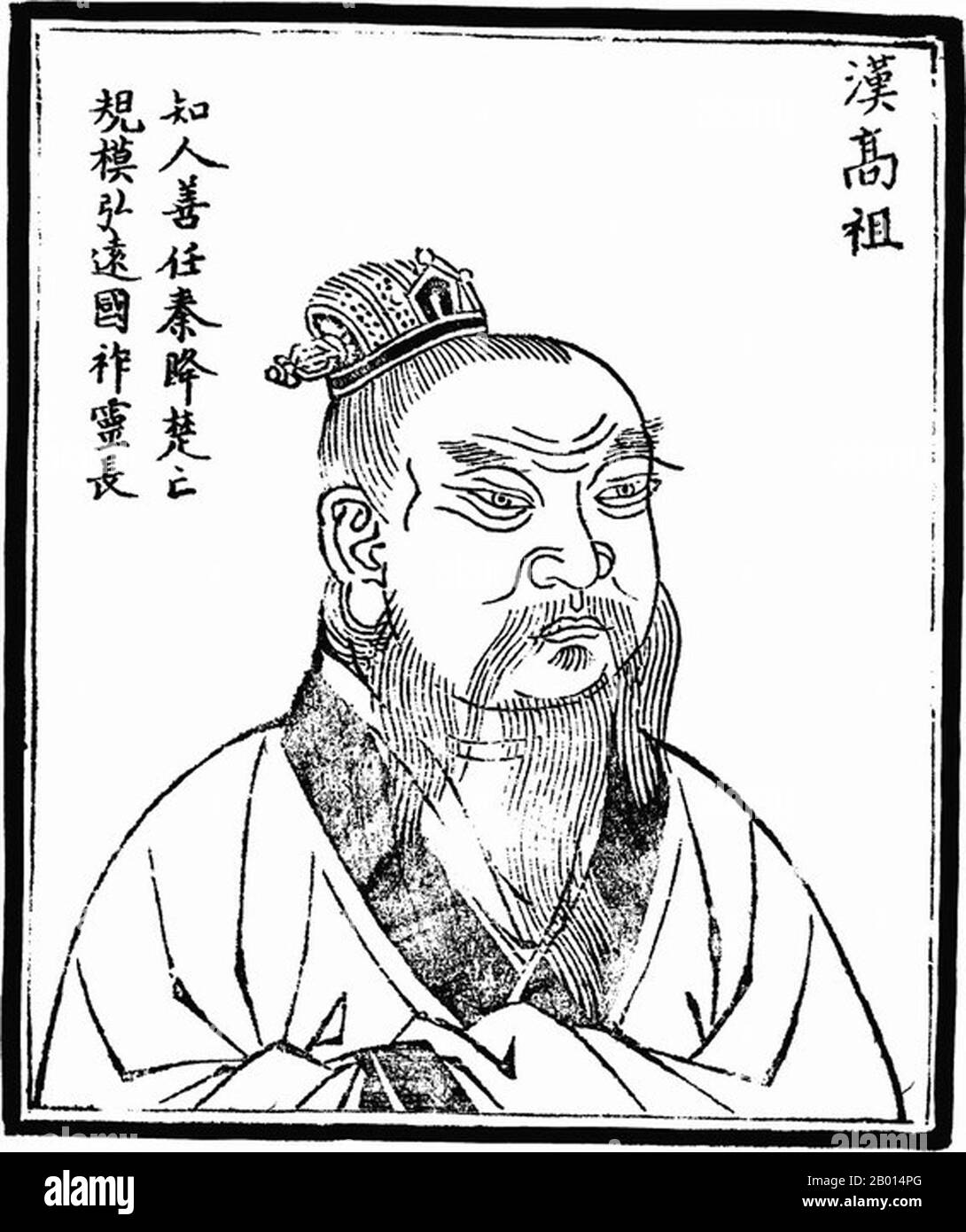 China: Emperor Gaozu (256 BCE – 1 June 195 BCE), founder and first ruler of the Western Han Dynasty (r. 206-195 BCE). Illustration, c. 1498. Emperor Gaozu (Wade-Giles: Kao Tsu), temple name Taizu and personal name Liu Bang, was the first emperor of the Han Dynasty. Liu was one of the few dynastic founders in Chinese history who emerged from the peasant class (another major example being Zhu Yuanzhang of the Ming Dynasty). In the early stage of his rise to prominence, Liu was addressed as 'Duke of Pei', referring to his hometown of Pei County. He was also granted the title of 'King of Han'. Stock Photohttps://www.alamy.com/image-license-details/?v=1https://www.alamy.com/china-emperor-gaozu-256-bce-1-june-195-bce-founder-and-first-ruler-of-the-western-han-dynasty-r-206-195-bce-illustration-c-1498-emperor-gaozu-wade-giles-kao-tsu-temple-name-taizu-and-personal-name-liu-bang-was-the-first-emperor-of-the-han-dynasty-liu-was-one-of-the-few-dynastic-founders-in-chinese-history-who-emerged-from-the-peasant-class-another-major-example-being-zhu-yuanzhang-of-the-ming-dynasty-in-the-early-stage-of-his-rise-to-prominence-liu-was-addressed-as-duke-of-pei-referring-to-his-hometown-of-pei-county-he-was-also-granted-the-title-of-king-of-han-image344233080.html
China: Emperor Gaozu (256 BCE – 1 June 195 BCE), founder and first ruler of the Western Han Dynasty (r. 206-195 BCE). Illustration, c. 1498. Emperor Gaozu (Wade-Giles: Kao Tsu), temple name Taizu and personal name Liu Bang, was the first emperor of the Han Dynasty. Liu was one of the few dynastic founders in Chinese history who emerged from the peasant class (another major example being Zhu Yuanzhang of the Ming Dynasty). In the early stage of his rise to prominence, Liu was addressed as 'Duke of Pei', referring to his hometown of Pei County. He was also granted the title of 'King of Han'. Stock Photohttps://www.alamy.com/image-license-details/?v=1https://www.alamy.com/china-emperor-gaozu-256-bce-1-june-195-bce-founder-and-first-ruler-of-the-western-han-dynasty-r-206-195-bce-illustration-c-1498-emperor-gaozu-wade-giles-kao-tsu-temple-name-taizu-and-personal-name-liu-bang-was-the-first-emperor-of-the-han-dynasty-liu-was-one-of-the-few-dynastic-founders-in-chinese-history-who-emerged-from-the-peasant-class-another-major-example-being-zhu-yuanzhang-of-the-ming-dynasty-in-the-early-stage-of-his-rise-to-prominence-liu-was-addressed-as-duke-of-pei-referring-to-his-hometown-of-pei-county-he-was-also-granted-the-title-of-king-of-han-image344233080.htmlRM2B014PG–China: Emperor Gaozu (256 BCE – 1 June 195 BCE), founder and first ruler of the Western Han Dynasty (r. 206-195 BCE). Illustration, c. 1498. Emperor Gaozu (Wade-Giles: Kao Tsu), temple name Taizu and personal name Liu Bang, was the first emperor of the Han Dynasty. Liu was one of the few dynastic founders in Chinese history who emerged from the peasant class (another major example being Zhu Yuanzhang of the Ming Dynasty). In the early stage of his rise to prominence, Liu was addressed as 'Duke of Pei', referring to his hometown of Pei County. He was also granted the title of 'King of Han'.
 China: Emperor Hongwu, 1st ruler of the Ming Dynasty (r. 1368-1398), 14th-17th century. The Hongwu Emperor, personal name Zhu Yuanzhang and temple name Taizu, was the founder and first emperor (1368–98) of the Ming Dynasty of China. His era name, Hongwu, means 'vastly martial'. In the middle of the 14th century, with famine, plagues and peasant revolts sweeping across China, Zhu became a leader of an army that conquered China, ending the Yuan Dynasty and forcing the Mongols to retreat to the Mongolian steppes. With his seizure of the Yuan capital (present-day Beijing), he became emperor. Stock Photohttps://www.alamy.com/image-license-details/?v=1https://www.alamy.com/china-emperor-hongwu-1st-ruler-of-the-ming-dynasty-r-1368-1398-14th-17th-century-the-hongwu-emperor-personal-name-zhu-yuanzhang-and-temple-name-taizu-was-the-founder-and-first-emperor-136898-of-the-ming-dynasty-of-china-his-era-name-hongwu-means-vastly-martial-in-the-middle-of-the-14th-century-with-famine-plagues-and-peasant-revolts-sweeping-across-china-zhu-became-a-leader-of-an-army-that-conquered-china-ending-the-yuan-dynasty-and-forcing-the-mongols-to-retreat-to-the-mongolian-steppes-with-his-seizure-of-the-yuan-capital-present-day-beijing-he-became-emperor-image344231632.html
China: Emperor Hongwu, 1st ruler of the Ming Dynasty (r. 1368-1398), 14th-17th century. The Hongwu Emperor, personal name Zhu Yuanzhang and temple name Taizu, was the founder and first emperor (1368–98) of the Ming Dynasty of China. His era name, Hongwu, means 'vastly martial'. In the middle of the 14th century, with famine, plagues and peasant revolts sweeping across China, Zhu became a leader of an army that conquered China, ending the Yuan Dynasty and forcing the Mongols to retreat to the Mongolian steppes. With his seizure of the Yuan capital (present-day Beijing), he became emperor. Stock Photohttps://www.alamy.com/image-license-details/?v=1https://www.alamy.com/china-emperor-hongwu-1st-ruler-of-the-ming-dynasty-r-1368-1398-14th-17th-century-the-hongwu-emperor-personal-name-zhu-yuanzhang-and-temple-name-taizu-was-the-founder-and-first-emperor-136898-of-the-ming-dynasty-of-china-his-era-name-hongwu-means-vastly-martial-in-the-middle-of-the-14th-century-with-famine-plagues-and-peasant-revolts-sweeping-across-china-zhu-became-a-leader-of-an-army-that-conquered-china-ending-the-yuan-dynasty-and-forcing-the-mongols-to-retreat-to-the-mongolian-steppes-with-his-seizure-of-the-yuan-capital-present-day-beijing-he-became-emperor-image344231632.htmlRM2B012XT–China: Emperor Hongwu, 1st ruler of the Ming Dynasty (r. 1368-1398), 14th-17th century. The Hongwu Emperor, personal name Zhu Yuanzhang and temple name Taizu, was the founder and first emperor (1368–98) of the Ming Dynasty of China. His era name, Hongwu, means 'vastly martial'. In the middle of the 14th century, with famine, plagues and peasant revolts sweeping across China, Zhu became a leader of an army that conquered China, ending the Yuan Dynasty and forcing the Mongols to retreat to the Mongolian steppes. With his seizure of the Yuan capital (present-day Beijing), he became emperor.
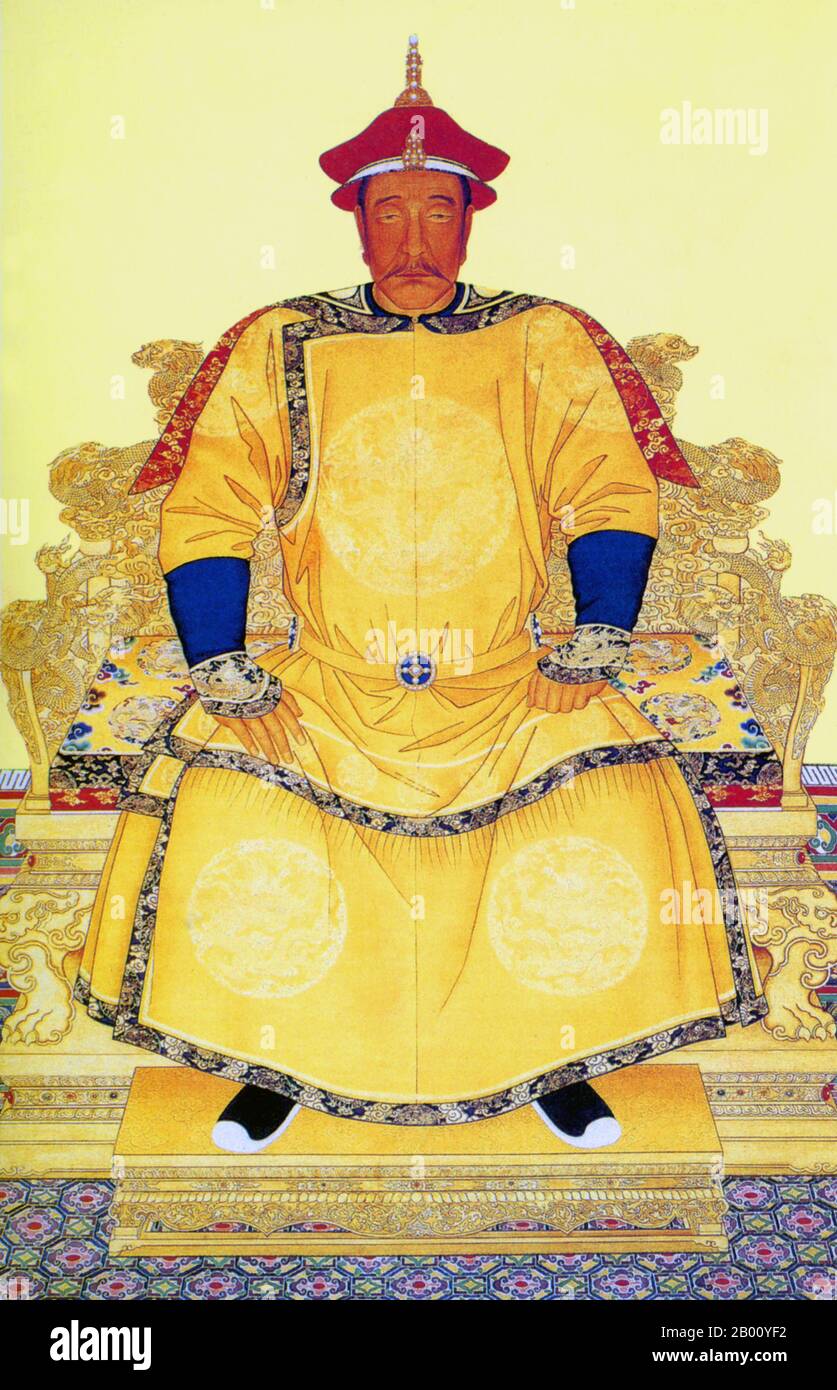 China: Emperor Nurhaci (1559 - 1626), temple name Taizu. Hanging scroll painting by a court painter, 17th century. Nurhaci, alternatively Nurhachi (February 21, 1559 – September 30, 1626) was an important Jurchen chieftain who rose to prominence in the late 16th century in what is today Northeastern China. Nurhaci was part of the Aisin Gioro clan, and reigned from 1616 to his death in September 1626. Nurhaci reorganized and united various Jurchen tribes to form the Manchu, consolidated the Eight Banners military system and eventually launched an assault on China proper's Ming Dynasty. Stock Photohttps://www.alamy.com/image-license-details/?v=1https://www.alamy.com/china-emperor-nurhaci-1559-1626-temple-name-taizu-hanging-scroll-painting-by-a-court-painter-17th-century-nurhaci-alternatively-nurhachi-february-21-1559-september-30-1626-was-an-important-jurchen-chieftain-who-rose-to-prominence-in-the-late-16th-century-in-what-is-today-northeastern-china-nurhaci-was-part-of-the-aisin-gioro-clan-and-reigned-from-1616-to-his-death-in-september-1626-nurhaci-reorganized-and-united-various-jurchen-tribes-to-form-the-manchu-consolidated-the-eight-banners-military-system-and-eventually-launched-an-assault-on-china-propers-ming-dynasty-image344228950.html
China: Emperor Nurhaci (1559 - 1626), temple name Taizu. Hanging scroll painting by a court painter, 17th century. Nurhaci, alternatively Nurhachi (February 21, 1559 – September 30, 1626) was an important Jurchen chieftain who rose to prominence in the late 16th century in what is today Northeastern China. Nurhaci was part of the Aisin Gioro clan, and reigned from 1616 to his death in September 1626. Nurhaci reorganized and united various Jurchen tribes to form the Manchu, consolidated the Eight Banners military system and eventually launched an assault on China proper's Ming Dynasty. Stock Photohttps://www.alamy.com/image-license-details/?v=1https://www.alamy.com/china-emperor-nurhaci-1559-1626-temple-name-taizu-hanging-scroll-painting-by-a-court-painter-17th-century-nurhaci-alternatively-nurhachi-february-21-1559-september-30-1626-was-an-important-jurchen-chieftain-who-rose-to-prominence-in-the-late-16th-century-in-what-is-today-northeastern-china-nurhaci-was-part-of-the-aisin-gioro-clan-and-reigned-from-1616-to-his-death-in-september-1626-nurhaci-reorganized-and-united-various-jurchen-tribes-to-form-the-manchu-consolidated-the-eight-banners-military-system-and-eventually-launched-an-assault-on-china-propers-ming-dynasty-image344228950.htmlRM2B00YF2–China: Emperor Nurhaci (1559 - 1626), temple name Taizu. Hanging scroll painting by a court painter, 17th century. Nurhaci, alternatively Nurhachi (February 21, 1559 – September 30, 1626) was an important Jurchen chieftain who rose to prominence in the late 16th century in what is today Northeastern China. Nurhaci was part of the Aisin Gioro clan, and reigned from 1616 to his death in September 1626. Nurhaci reorganized and united various Jurchen tribes to form the Manchu, consolidated the Eight Banners military system and eventually launched an assault on China proper's Ming Dynasty.